Sony A5880016 GSM/UMTS/HSPA Mobile Phone with WLAN, BT, RFID and ANT+ User Manual
Sony Mobile Communications Inc GSM/UMTS/HSPA Mobile Phone with WLAN, BT, RFID and ANT+
Sony >
User Manual
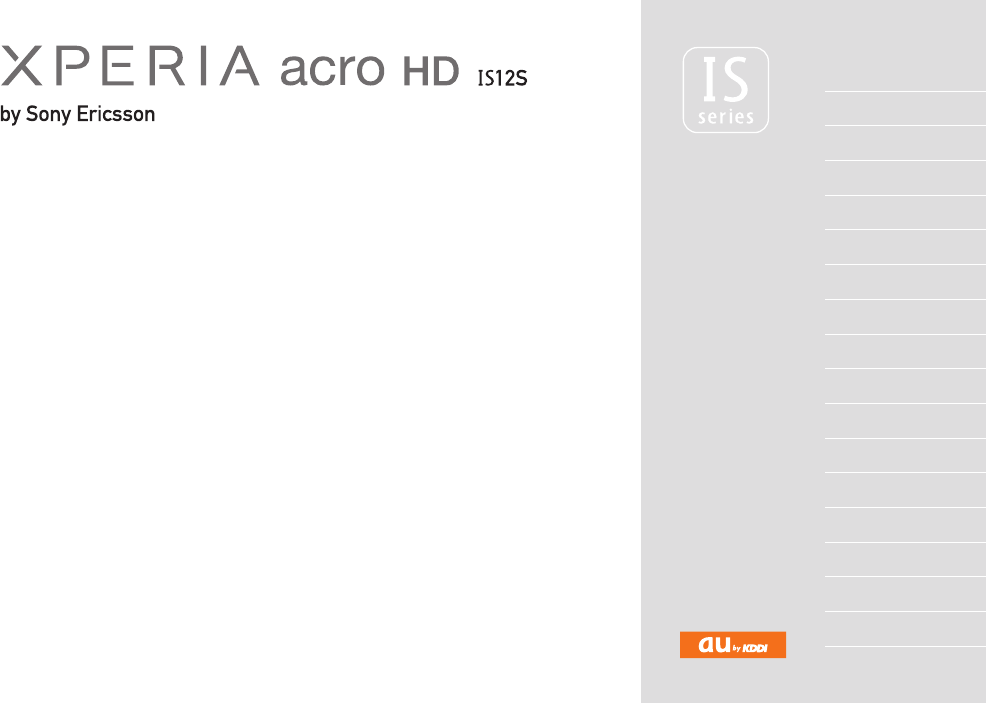
Basic Manual
I S11S 取扱説明書 詳細版
Illustrations and
Screenshots in
This Manual
Applications
Viewing the
Setting Menu
Troubleshooting
Index
Notes on
Cell Phone Use
Contents
Getting Ready
Learning the Basics
Making and
Answering Calls
Global Function
Character Input
Contacts
Mail
Camera
Web Browser
TV (1Seg)
For inquiries, call: au Customer Service Center
For general information and charges (toll free)
For loss, theft or damage and operation information
(toll free)
From fixed-line phones:
PRESSING ZERO WILL CONNECT YOU TO AN OPERATOR
AFTER CALLING 157 ON YOUR au CELL PHONE
From au cell phones:
From fixed-line phones: From au cell phones:
area code not required
area code not required
In case above numbers are not available,
Cell phone and PHS operators collect and recycle unused
telephones, batteries and battery chargers at stores
bearing the logo regardless of brand and manufacturer
to protect the environment and reuse valuable resources.
Sales: KDDI CORPORATION •
OKINAWA CELLULAR TELEPHONE COMPANY
Manufactured by: Sony Ericsson Mobile Communications Japan, Inc.
1250-0245.1
June 2011,1st Edition

Introduction
Thank you for purchasing the IS12S. Before using your IS12S, be sure to read the IS12S Basic Manual (this PDF manual) to
ensure correct usage. After you have finished reading this manual, store this PDF manual and the printed manuals in safe
places so you can retrieve them whenever you need them.
Manuals for the IS12S
There are three manuals for the IS12S: the Basic Manual, printed スタートガイド (Start guide) (Japanese) and full
Instruction Manual (Japanese).
● For learning the basics:
Read the IS12S Basic Manual (this manual) or printed IS12S スタートガイド (Start guide) (Japanese).
● Instruction Manual (Japanese) application:
IS12S provides you with preinstalled "Instruction Manual" (Japanese) application for detailed descriptions.
● Downloading Manuals:
You can download following PDF manuals (Japanese), "スタートガイド (Start guide)", "設定ガイド (Setting guide)", "au
oneメール設定ガイド (au one mail setting guide)" and "取扱説明書詳細版 (full Instruction Manual)" from au homepage.
http://www.au.kddi.com/torisetsu/index.html
To ensure proper usage of the IS12S, be sure to read the Safety Precautions "安全上のご注意" in the Instruction Manual.
The keyword searchable au Online Manual is also available on the au homepage:
http://www.au.kddi.com/manual/index.html
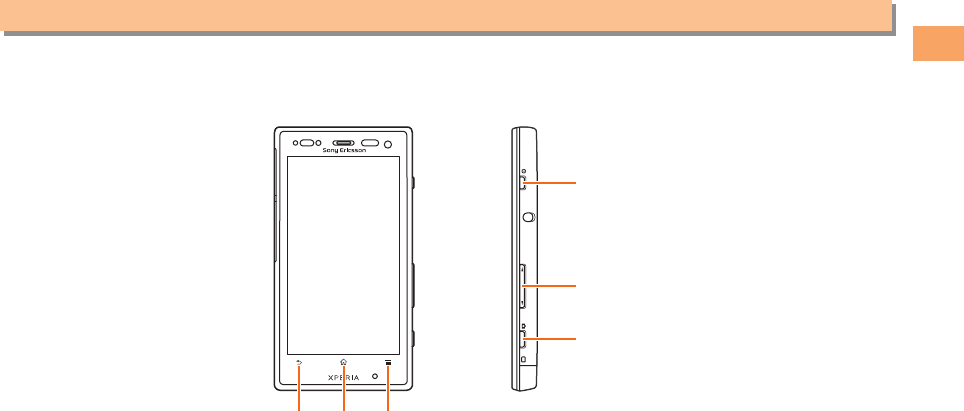
1
Illustrations and Screenshots in This Manual
Illustrations and Screenshots in This Manual
Note on Illustrations
The illustrations in this manual may look different from the actual cell phone in shape, color and typeface. The key
illustrations are also simplified as shown below.
P
N
S
[\W
Note on Screenshots
The screenshots in this manual are simplified and may look different from the actual cell phone screens.
■
■
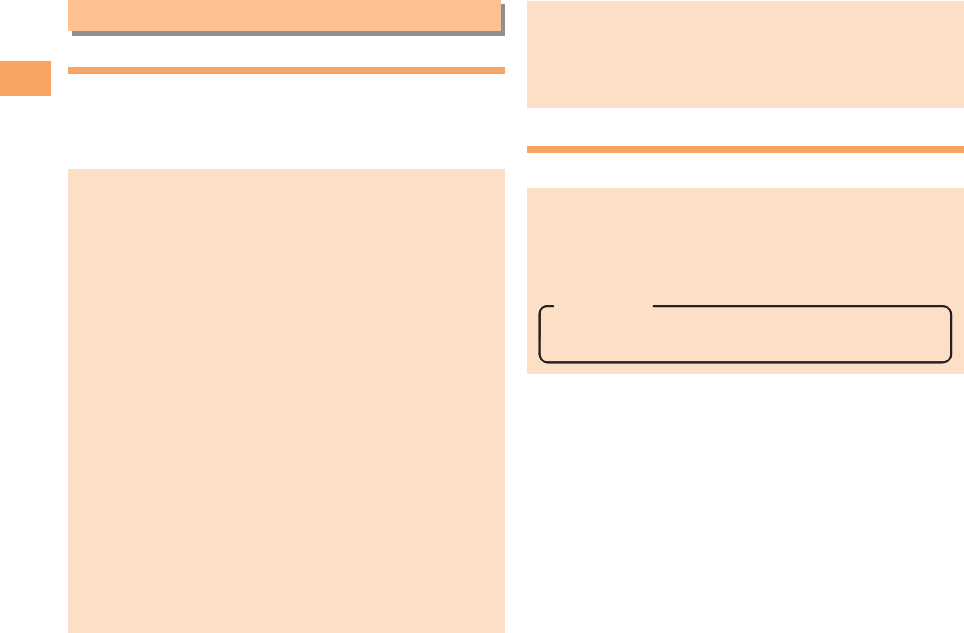
2
Notes on Cell Phone Use
Notes on Cell Phone Use
Cell Phone Etiquette
The cell phone always emits weak radio waves when power
is on.
Use the cell phone in an enjoyable and safe manner without
forgetting to be considerate of others around you.
Use of cell phones is not allowed in some places.
Do not use the cell phone while you are driving. Doing
so is both dangerous and prohibited by law.
Using a cell phone in an aircraft is prohibited by law.
Set Airplane Mode to on and turn the cell phone power
off.
Radio waves from cell phones may interfere with
medical electrical equipment.
Some people close to you in crowded places such
as packed trains may be using a cardiac pacemaker.
Turn the cell phone off in such places.
Abide by the rules of hospitals and other medical
institutions where it is forbidden to use or carry cell phones.
Be considerate of where you use the cell phone and
how loudly you talk.
Do not make calls in theaters, museums, libraries, and
other similar places. Turn power off or turn on silent
mode not to disturb others around you by ringtones.
Do not use the cell phone on a street where you might
interrupt the flow of pedestrians.
Move to areas where you will not inconvenience others
on trains or in hotel lobbies.
Refrain from talking in a loud voice.
●
•
•
●
•
•
●
•
•
•
•
Obtain the permission of other people before you take
their photos with the cell phone's camera.
Do not record information with the cell phone's camera
in bookstores and other locations where taking photos
is not permitted.
Do Not Use the Cell Phone While Driving!
Turn off your cell phone while driving.
Do not use the cell phone while driving a car/motorcycle
or riding a bicycle. It may result in a traffic accident. Using
a cell phone while driving is prohibited by law. Using a
cell phone while riding a bicycle may also be punishable
by law.
Prohibited!
Looking at a cell phone display
Talking on a cell phone while holding it
•
•
•
•
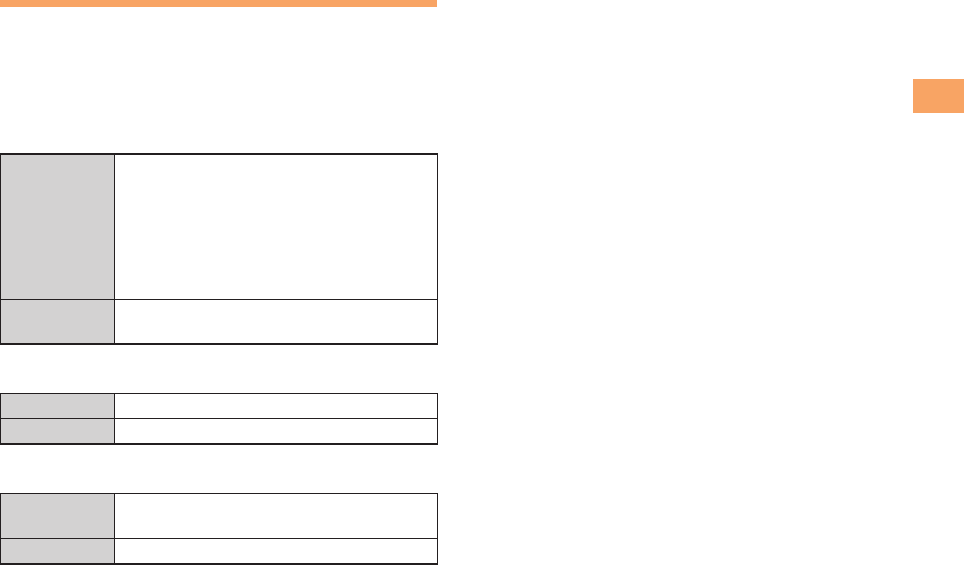
3
Notes on Cell Phone Use
Security Code and Passwords
You can use a security code and other passwords
described below.
Take care not to forget your security code and passwords,
because they are required for performing various
operations and using subscription services.
Security Code
Usage
Example
①Using the Answering Service (Voice
Mail) and Call Transfer remotely from a
fixed-line phone
②Making inquiries, applications, and
changes while using au Customer
Service Center voice guidance, au web
pages
Initial Setting The four-digit number you wrote on your
subscription form
Set up screen lock
Usage Setting/canceling screen lock
Default value None
PIN code
Usage Preventing unauthorized use of au IC-
Card
Default value 1234
■
■
■

4
Contents
Contents
Introduction ii
Illustrations and Screenshots in This Manual
1
Notes on Cell Phone Use 2
Cell Phone Etiquette ..................................................... 2
Do Not Use the Cell Phone While Driving! ................... 2
Security Code and Passwords ..................................... 3
Contents 4
Getting Ready 6
Checking the Contents of the Box ................................ 6
Names of Parts ............................................................. 7
Charging the Battery Pack............................................ 9
Turning On Power ....................................................... 10
Initial Setup ................................................................. 11
Setting Google Account .............................................. 11
Checking Your Phone Number.................................... 11
Inserting/Removing microSD Memory Card ............... 12
Learning the Basics 13
Operating the Touch Panel ......................................... 13
Operation While Using Functions ............................... 14
Viewing the Home Screen .......................................... 15
Using the Status Bar .................................................. 15
Using the Notification Panel ....................................... 17
Using the Home Screen ............................................. 17
Using the Applications Screen ................................... 18
Illustration for Inserting microSD Memory Card ......... 20
Removing au IC-Card ................................................. 20
Making and Answering Calls 21
Making a Call .............................................................. 21
Making an International Call ....................................... 21
Answering a Call ........................................................ 22
Returning a Call
(Outgoing History/Incoming History) .......................... 22
Setting the Silent Mode .............................................. 22
Setting a Ringtone ...................................................... 23
Enabling Touch Tones ................................................. 23
Adjusting the Sound Volume ...................................... 23
Global Function 24
Setting the Area .......................................................... 24
Switching Network Manually ...................................... 24
Obtaining the Latest PRL (Preferred Roaming List) ... 24
Making a Call to Outside Country You Stay
(Including Japan) ........................................................ 25
Character Input 26
Selecting Input Method ............................................... 26
Software Keyboard ..................................................... 26
Switching the Keyboard .............................................. 26
Entering Characters on the QWERTY Keyboard........ 26
Entering Characters on the 12 key Keyboard ............. 28
Entering Characters on the Japanese Syllabary
Keyboard .................................................................... 30

5
Contents
Contacts 31
Saving a Contact ........................................................ 31
Dialing from the Contacts ........................................... 31
Editing Contacts ......................................................... 31
Mail 32
Using C-mail ............................................................... 32
Creating and Sending C-mail Messages .................... 32
Reading Received C-mail Messages ......................... 33
Using PC-mail ............................................................ 33
Using Gmail ................................................................ 34
Camera 35
Photo Taking Tips ....................................................... 35
Setting Image Size for Photo ...................................... 35
Taking a Photo ............................................................ 36
Viewing Photos (Gallery) ............................................ 36
Web Browser 37
Viewing Sites with Web Browser ................................ 37
Displaying a Web Page............................................... 37
Moving to a Web Page ............................................... 37
Using Windows ........................................................... 37
Using Bookmarks/History ........................................... 38
TV (1Seg) 39
Initial Setup of the TV (1Seg) ..................................... 39
Watching TV (1Seg) ................................................... 39
Basic Operations ........................................................ 40
Applications 41
Using Android Market ................................................. 41
Managing Applications ............................................... 41
Viewing the Setting Menu 43
Starting the Setting Menu ........................................... 43
Troubleshooting 44
Index 46
Radio Wave Exposure and Specific
Absorption Rate (SAR) Information 49
Radio Frequency (RF) exposure and Specific Absorption
Rate (SAR) ................................................................. 50
Guidelines for Safe and Efficient Use ......................... 51
FCC Statement for the USA ....................................... 54
Industry Canada Statement ....................................... 55
Declaration of Conformity for CDMA SOI12 ............... 56
End User Licence Agreement 57
About Open Source Software 58
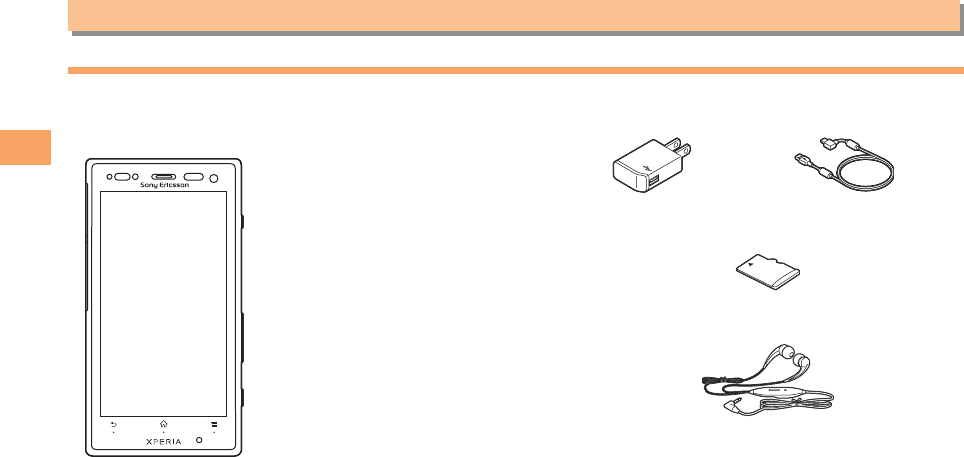
6
Getting Ready
Getting Ready
Checking the Contents of the Box
The box contains the cell phone and accessories.
IS12S (with warranty and battery pack
cover)
• AC Adapter EP800 (with warranty)
microSDHC card (32GB)* (Sample)
* Inserted in the IS12S when purchased.
Stereo Headset with Microphone (Sample)
•
•
•
スタートガイド (Start guide) (Japanese)
IS12Sのご利用にあたっての注意事項 (Cautions on using IS12S)
(Japanese)
携帯電話の比吸収率などについて (Specific Absorption Rate of
Mobile Phone, etc.)
設定ガイド (Setting guide) (Japanese)
au oneメール設定ガイド (au one mail setting guide) (Japanese)
•
•
•
•
•
<AC adapter> <microUSB cable (Sample)><AC adapter> <microUSB cable (Sample)>
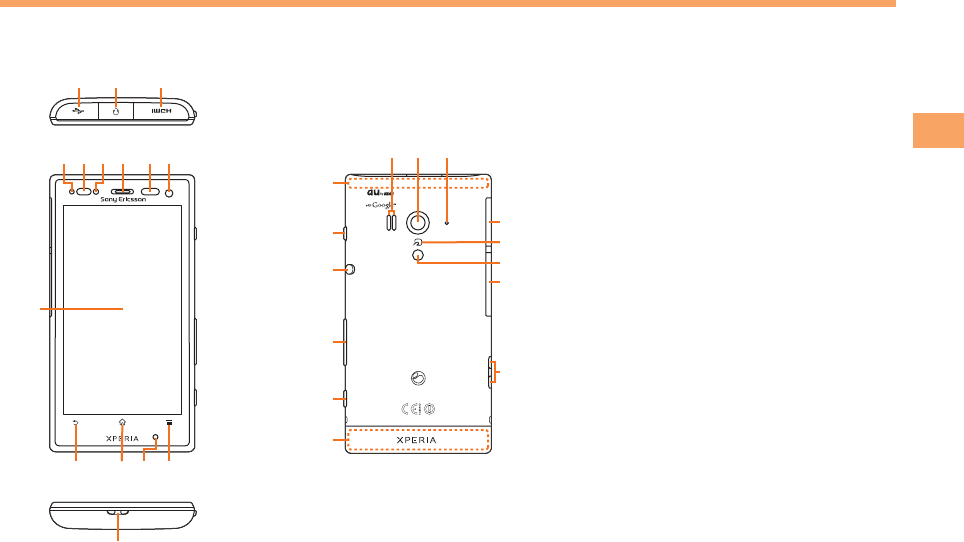
7
Getting Ready
Names of Parts
From the Front■
TYPE:AAH-5880016-BV FCC ID:PY7A5880016 IS12S
defg hi
a b c
k l nm
j
o p q
y
z
B
x
A
u
v
r
w
s
t
C
TYPE:AAH-5880016-BV FCC ID:PY7A5880016 IS12S
defg hi
a b c
k l nm
j
o p q
y
z
B
x
A
u
v
r
w
s
t
C
From the Back■
*1 Do not cover the antenna area with your hand when
using Wi-Fi, Bluetooth® or retrieve GPS information.
*2 Do not cover the antenna area with your hand during a
call or when using the browser.

8
Getting Ready
⑲ p Power key/Screen lock key
Turns on/off power. Also, turns off the backlight and sets
key lock.
⑳ Whip antenna
Extend it when watching TV (1Seg). It has no influence
on calls or data communication if you extend the whip
antenna when calling or using browser.
m Volume key/Zoom key
k Camera key
Hold it down for at least one second to activate Camera.
Use it as a shutter to take photos or movies.
Built in antenna*2
microSD memory card slot
FeliCa™ mark
Hold it over card reader/writer when using Osaifu-
Keitai®.
Flash/Photo light
Lights to brighten an object when taking a photograph.
au IC-Card slot
Charge terminal
Strap hole
① microUSB connecting terminal
② Headset connector
③ HDMI connector (type D)
④ Notification LED
Notifies charging condition, missed call or unread mail.
⑤ Proximity sensor
Turns on or off the touch screen to prevent erroneous
operation during a call.
⑥ Light sensor
Adjusts screen brightness. Do not cover it with your
fingers etc.
⑦ Ear speaker
Allows you to hear the other party's voice etc. during a
call.
⑧ Infrared port
Sends and receives data via infrared communication.
⑨Frontcamera lens
⑩ Display (Touch panel)
⑪ x Back key
Returns to the previous screen.
⑫ y Home key
Displays home screen.
⑬ Microphone
Transmits your voice to the other caller.
⑭ t Menu key
Displays menu according to the operating conditions.
⑮ Speaker
⑯Camera lens
⑰ Second Microphone
Reduces noise to make easy to listen.
⑱GPS/Bluetooth®/Wi-Fi antenna*1

9
Getting Ready
Charging the Battery Pack
The battery pack is not fully charged at the time of purchase.
Be sure to charge the battery pack before using the cell
phone for the first time.
Use the included AC adapter cable when charging.
When you start charging the battery with the IS12S
powered off, the power turns on. However, you cannot
operate the au phone. Do not charge the battery in a
place where the use is prohibited such as in airplane
or hospital.
Charging the Battery Pack with the AC
Adapter
Included AC adapter cable is necessary.
1 Insert the microUSB cable horizontally with the
microUSB plug engraved side facing down
into the connector for microUSB cable of the
IS12S.
2 Insert the microUSB cable horizontally with
the USB plug engraved side facing up into
the connector for USB of the AC Adapter, and
insert the AC Adapter plug to the power outlet.
Notification LED of IS12S turns on and appears.
3 When the charging is completed, remove the
microUSB plug of the microUSB cable from the
IS12S.
•
•
■
•
4 Remove the AC Adapter from the power outlet.
Charging the Battery Pack with a PC
Included microUSB cable is necessary. Check the
connecting direction to connect correctly. Wrong
connection may cause damage.
1 Insert the microUSB cable horizontally with the
microUSB plug engraved side facing down
into the connector for microUSB cable of the
IS12S.
2 Insert the USB plug of the microUSB cable into
the USB port of a PC.
Notification LED of IS12S turns on and appears.
When a confirmation screen for installation of PC
Companion software appears on the IS12S, tap Skip.
When a screen for new hardware detection etc.
appears on the PC, select Cancel.
3 When the charging is completed, remove the
microUSB plug of the microUSB cable from the
IS12S.
■
•
•
•
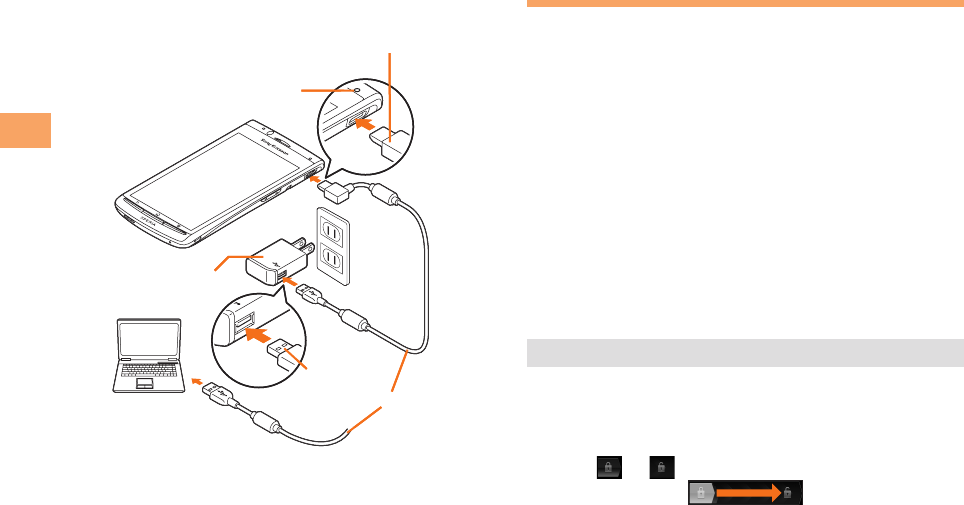
10
Getting Ready
4 Remove the USB plug of the microUSB cable
from the USB port of the PC.
microUSB plug
AC Adapter
USB plug
microUSB cable
Notification LED
microUSB plug
AC Adapter
USB plug
microUSB cable
Notification LED
Turning On Power
1 p (hold down for at least one second)
The key unlock screen appears. Deactivate the key
lock.
Turning Off Power
1 p (hold down for at least one second)
2 Power Off → OK
Setting Key Lock
If the key lock is set, the screen light turns off to avoid
erroneous operations of touch screen or buttons. The IS12S
keys are locked with turning the screen light off after the
specified time duration.
1 While the screen is displayed, p.
There is no function to deactivate the key lock.
Unlocking Key Lock
A key unlock screen appears when turning the power on or
the backlight on by pressing p/y.
1 Drag to .
•
■
■
•
■

11
Getting Ready
Initial Setup
The first time IS12S turns ON, the initial setting screen
appears automatically. After setting the display language,
"Setup guide" appears. Follow the onscreen instructions to
set each function.
1 English (United States) →
次へ
(Next)
You can check the operations of main functions and
initial settings.
2 Next
Tap Change to change Date & time.
3 Next
Tap View to check how to use the keyboard.
4 Next
Tap View to check how to use the application
Timescape™.
5 Next
Tap Set up to set up services you want to use.
You can set up the services afterward in the following
procedure: From the Home screen, tap → Setup
guide or from the settings screen, select each item.
6 Next → Finish
•
•
•
•
•
•
Setting Google Account
You can create a Google account on the IS12S and use
Google services. Google account setup screen appears
such as when launching a software that requires a Google
account for the first time. You can also display it from Setup
guide.
1 Google account setup screen → Next
2 Create/Sign in
If you already have a Google account, tap login, enter
user name and password and tap login. If you have no
Google account, tap Create and register an account
following the onscreen instructions.
Checking Your Phone Number
Your phone number appears at the top of the contact list.
You can edit your contact information such as a name, mail
address, etc.
1 From the Home screen, → Contacts
2 Tap [XXX-XXXX-XXXX] (Myself) at the top of the
contact list.
3 Edit
4 Done
•

12
Getting Ready
Inserting/Removing microSD
Memory Card
You can save, move or copy data by inserting micoSD
memory card (including microSDHC) into the IS12S. And
you can copy contacts etc. to microSD memory card.
A microSDHC memory card (32GB) (sample) is
inserted in the IS12S when purchased.
When a microSD card is not inserted, camera
functions, playing, downloading music or videos or
infrared communication are not available.
Inserting microSD Memory Card
Illustration for inserting, see "Illustration for Inserting
microSD Memory Card" (P.20).
1 Turn the IS12S off, put your tip of thumb (nail)
into the groove, and hold the battery pack
cover up to remove.
2 Check the orientation of microSD memory
card, and insert it slowly straight until it clicks.
Insert a microSD memory card, with the metal contact
side facing up. Make sure that you hear it click and
lock in place. Note that microSD memory card may
pop up if you release your finger before locked.
3 Check the direction of the battery pack cover
and attach to the cell phone body, press each
tab to close it firmly.
•
•
■
•
Removing microSD Memory Card
When removing the microSD memory card, be sure to
unmount first.
1 From the Home screen, t → Settings →
Storage → Unmount SD card
appears in the status bar when unmounted.
2 Turn the IS12S off, put your tip of thumb (nail)
into the groove, and hold the battery pack
cover up to remove.
3 Insert the microSD memory card straight into
the slot all the way until it clicks.
If you hear a click, pull your finger back while touching
the microSD memory card. Keep touching the
microSD memory card because it pops out a little. Be
careful that it may pop out strongly if you press it hard
and release your finger.
4 Pull out microSD memory card slowly.
Slowly pull it out straight.
If the microSD memory card does not pop out, gently
draw it out with your fingers to remove.
Do not pull out microSD memory card forcibly. May
cause data loss or malfunction.
5 Check the direction of the battery pack cover
and attach to the cell phone body, press each
tab to close it firmly.
■
•
•
•
•
•
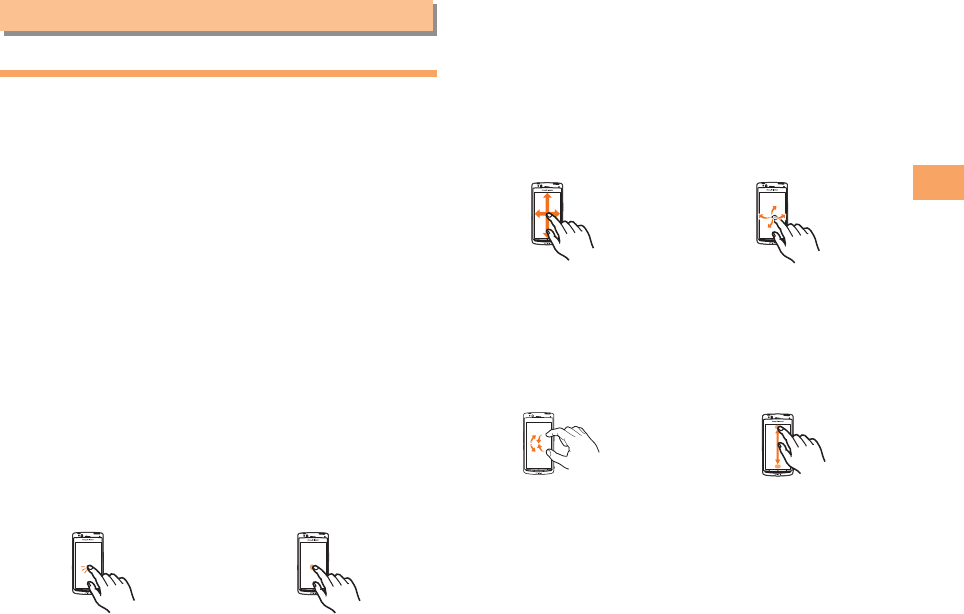
13
Learning the Basics
Learning the Basics
Operating the Touch Panel
The display of the IS12S is a touch panel. You can operate
the IS12S by directly touching the screen.
Touch panel is designed for being touched lightly with
fingers. Do not push it forcibly with a finger or press it with
sharp objects (nail, ballpoint pen, pin, etc.).
Touching the touch panel may not work in the following
cases. Note that it may cause malfunction.
- Operation with gloved hands
- Operation with a fingernail or foreign object on the
screen
- Operation with protective sheet or seal on the screen
- Operation with wet hands
- Operation when waterdrop attached on the touch panel
Basic Operations
Tap/Double Tap
Tap: Gently touch a screen
and then immediately
release your finger.
Double tap: Tap the same
position twice.
Long Touch
Keep touching an item of
key.
•
•
■
Slide
While your finger is gently
touching the screen, trace
it to the desired direction to
move over.
Flick
Operate the screen by
quickly moving (flicking)
your finger up, down, right,
or left.
Move the finger slowly
in the beginning, then
flick away in the end.
•
Pinch
Touch the screen with two
fingers and widen (pinch-
out) or narrow (pinch-in) the
fingers' distance.
Drag
Keep touching an item or
icon, trace it to the desired
direction to move.
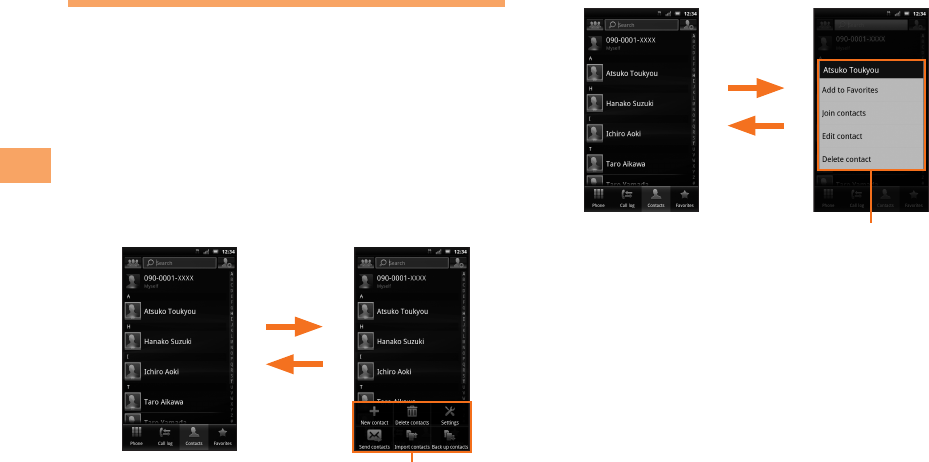
14
Learning the Basics
Operation While Using Functions
Frequently used operations for IS12S are described in this
section.
Selecting an Item
You can directly tap the screen to select a displayed item
or icon.
Displaying the Menu
Menu options can be displayed by pressing the menu key
(t), or long-touching an entry field or item.
Example: Pressing t in the contact list screen
Menu
<Contact list screen>
x
t
■
■
Example: Long-touching a contact in the contact list screen
Menu
<Contact list screen>
x
Long-touch
a contact
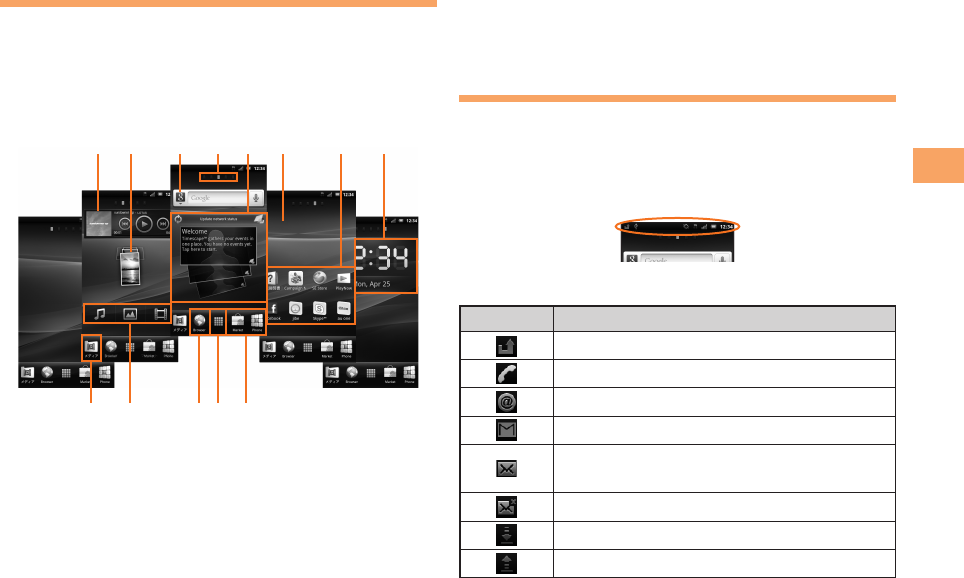
15
Learning the Basics
Viewing the Home Screen
Display indicators inform you of mail arrival, current
settings, etc.
The Home screen consists of five screens, the center
screen and two for each side. The center screen is the
default screen to operate the cell phone. Pressing y
returns to the Home screen at any time.
A B C D F G KE
H I G J G
① Widget: Music player
② Widget: Photos and videos
③ Widget: Search
④ Current position of the Home screen
Indicates which screen of the five Home screens you are
in.
⑤ Widget: Timescape™
⑥ Wallpaper
⑦ Shortcuts (applications)
⑧ Media folders (Music, Gallery, FM radio and 1Seg)
⑨ Widget: Media shortcuts
⑩ Application keys
⑪ Widget: Digital clock
Using the Status Bar
The status bar is located at the top of the IS12S screen.
Notification icons which inform missed calls, new arrival
mail, operations in progress, etc. appear on the left of the
status bar, and status icons which indicate the status of the
IS12S appear on the right.
Main Notification Icons
Icon Overview
Missed call
Calling
New PC mail message
New Gmail message
New C-mail/Answering memo for Answering
Service (Voice Mail)
Problem with C-mail message delivery
Receiving/Downloading data
Sending/uploading data
■
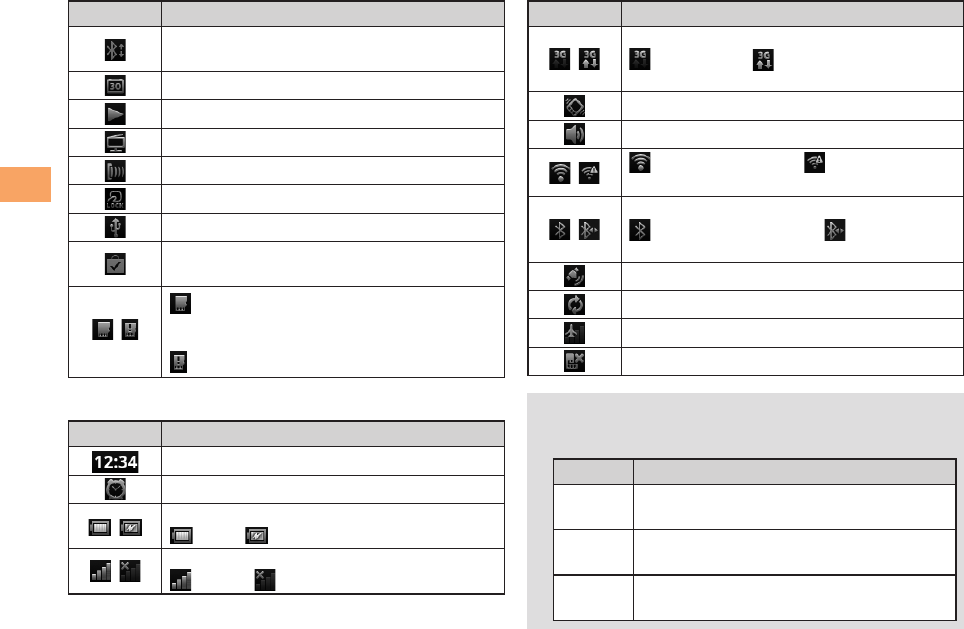
16
Learning the Basics
Icon Overview
Bluetooth® function connection request
notification
Upcoming calendar event
Playing a track
1Seg activated
Infrared communication in progress
Osaifu-Keitai® is locked.
USB is connected.
Software update notification or updating
software
/
microSD memory card unmounted, ready
to be removed (reading and writing
unavailable)/
microSD memory card removed
Main Status Icons
Icon Overview
Time
Alarm set
/ Battery level
100%/ Charging
/ Strength of radio wave
Level 4/ No signal
■
Icon Overview
/
3G data communication status
3G available/ Sending and
downloading 3G data
Silent Mode (Vibration) set
During a call using hands-free (speaker on)
/ Connecting to Wi-Fi/ Connecting to
Wi-Fi using AutoIP function
/
Using Bluetooth®
Bluetooth® function on/ Connecting to
Bluetooth® compatible device
GPS positioning in progress
During Data synchronization
Airplane mode is activated.
au IC card is locked or not inserted.
Notification LED informs charging prompt, battery
level while charging, missed calls, mail arrival, etc. by
turning on or flashing.
Status Description
Red The battery is charging when the
remaining battery level is less than 10 %.
Orange The battery is charging when the
remaining battery level is 10 %-90 %.
Green The battery is charging when the
remaining battery level is 90 % or more.
•
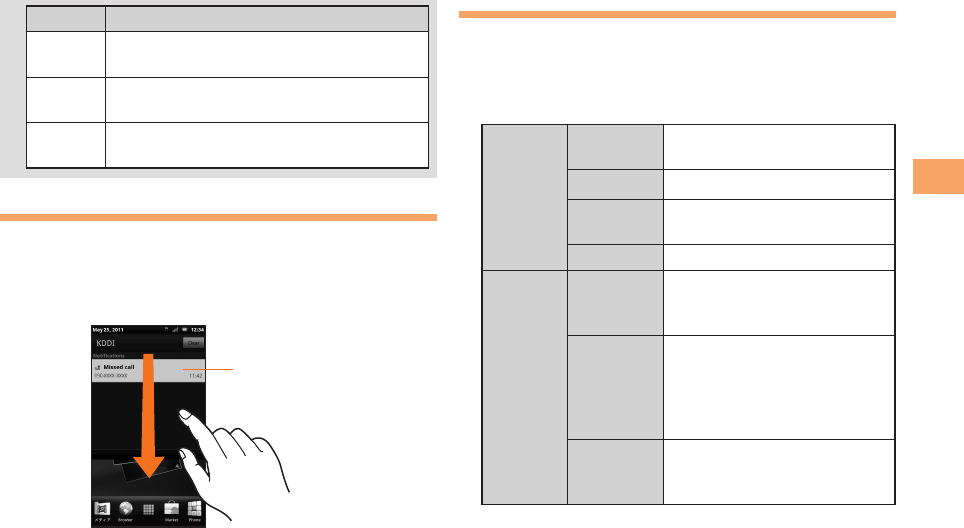
17
Learning the Basics
Status Description
Flashing
red
The battery level is not enough for
activating the cell phone for turning on.
Flashing
green
While backlight is off, missed calls/New
email messages exist.
Flashing
white A call is received.
Using the Notification Panel
Notification icons are displayed in the Notification panel.
You can check details of notification icons or start
corresponding applications.
1 Slide the status bar downward.
Notification panel
Tap Dismiss all to delete notifications.•
Using the Home Screen
You can change the wallpaper, add, delete, or move
application shortcuts, widgets, folders from the Home
screen.
1 From the Home screen, t
2
Add
Shortcuts Add shortcuts of applications
or bookmarks.
Widgets Add widgets.
Folder Add folders. Folder names
can be changed.
Wallpapers Change wallpaper of IS12S.
Wallpaper
Gallery
Select an image from an
album in the Gallery to set
wallpaper.
Live
wallpapers
Select a preinstalled live
wallpaper to set wallpaper.
You can also download and
add live wallpapers from a
website.
•
Sony
Ericsson
wallpapers
Select a preinstalled image
to set wallpaper.
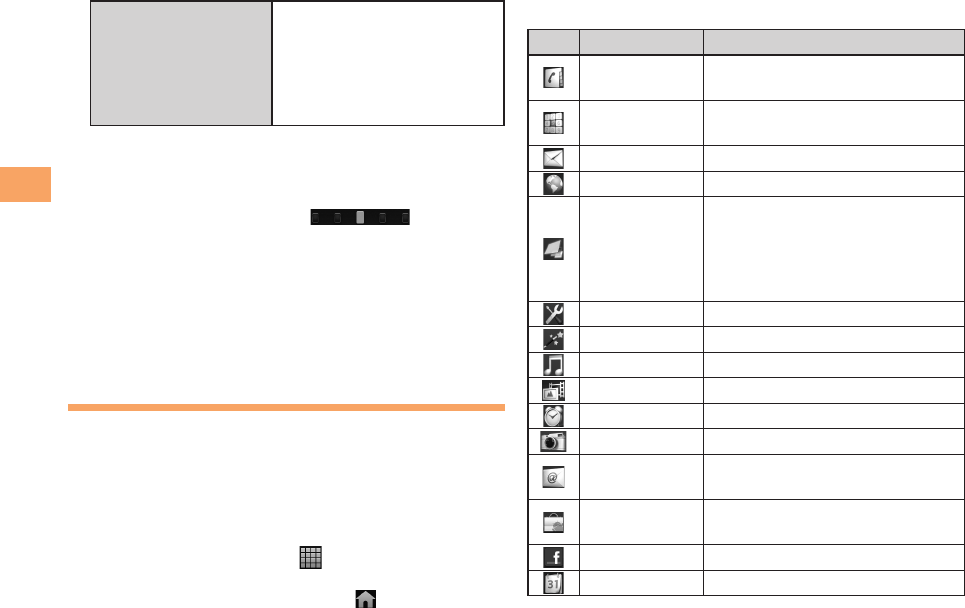
18
Learning the Basics
Settings
Set and manage IS12S
functions from the setting
menu. Personalizing
wallpaper and ringtone,
security settings, initializing
data, etc. are available.
Switching the Home Screen
Slide/Flick the Home screen left or right to move to the
neighboring Home screen. You can check the current
position of the Home screen with at the top of
the screen.
Using Widgets
Widgets are applications which can be registered on the
Home screen. Pinch in on the Home screen to display a list
of the widgets on the Home screen. To return to the Home
screen, pinch-out or tap Exit overview.
Using the Applications Screen
You can call up functions from the Applications screen.
Application icons installed to the IS12S are also displayed.
When you tap an icon to use function, communication
fees may be charged depending on the function.
Displaying Applications Screen
1 From the Home screen,
Slide/Flick left or right to switch the Applications screen.
To close the Applications screen, tap or press x/
y.
■
■
•
■
•
Main Applications
Icon Application Overview
Contacts Keep contacts of your friends
and colleagues.
Phone Make a call, receive a call,
display call history, etc.
C-mail Send or receive C-mail.
Browser Access Internet.
Timescape™
View Social Networking Service
(SNS), missed calls, message
(SMS) history. You can make a
call, send a message, etc. from
the history.
Settings Make settings for the IS12S.
Setup guide Show Setup guide.
Music Play music.
Gallery View photos or movies.
Alarms Set alarm.
Camera Take photos or record movies.
Email PC-mails (multiple accounts are
also available) can be used.
Market Download and buy new
applications.
Facebook Activate "Facebook" application.
Calendar Manage schedule.
■
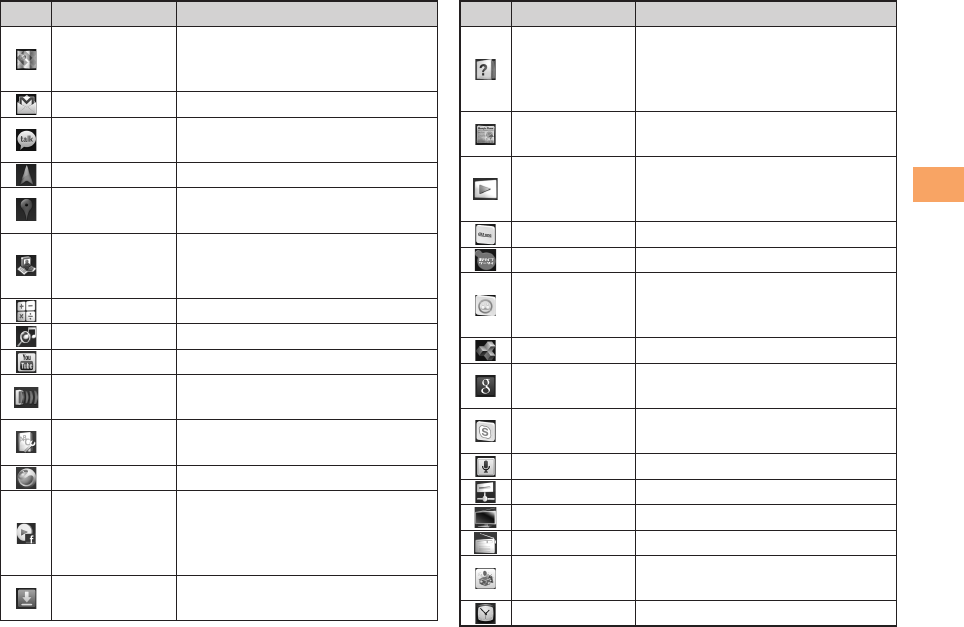
19
Learning the Basics
Icon Application Overview
Maps
View current location, find
another locations and calculate
routes.
Gmail Use Gmail.
Talk You can use Google Talk instant
messaging to chat with friends.
Navigation Display Google Map Navigation.
Places You can use information
registered on Google Map.
Latitude
A communication tool to share
and use your location information
with members.
Calculator Basic calculation is available.
TrackID™ Use music recognition service.
YouTube Play movies on YouTube.
Infrared Sending or receiving data via
infrared communication.
定型文
(Phrase
application)
Manage phrases to quote when
entering characters.
SE Store Access SE Store.
Media
Discovery
Display music or movie
information registered in "いい
ね!(Like)" on Facebook by you
or "Friend".
Downloads Display a list of downloaded
items.
Icon Application Overview
取扱説明
書IS12S
(Instruction
Manual)
Display the instruction manual for
the IS12S.
News &
Weather Display news and weather.
PlayNow
Access PlayNow website to use
news flash, dictionary service,
etc.
au one Access au one website.
Osaifu-Keitai Use Osaifu-Keitai®.
jibe
An application to enjoy Social
Networking Service (SNS) such
as Twitter, mixi, etc.
OfficeSuite View files for Word, Excel, etc.
Google Search Search information in the IS12S
and web pages.
Skype™ Use voice call and Instant
message (chat).
Voice Search Search by voice.
Media server Set and manage Media server.
1Seg Watch 1Seg.
FM radio Listen FM radio.
Campaign Navi View campaign information for
Xperia.
Clock Set an alarm, clock, etc.
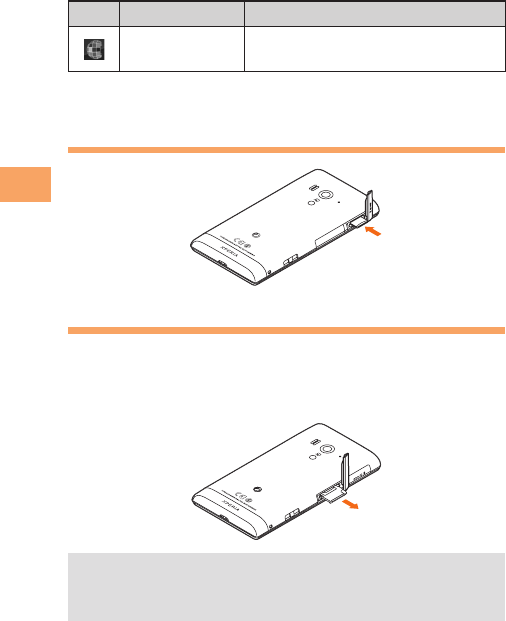
20
Learning the Basics
Icon Application Overview
life.episode™ View the latest information such
as news or music.
Illustration for Inserting microSD
Memory Card
Removing au IC-Card
1 Remove the back cover, press the au IC-Card
with your fingertip and remove it sliding
outside.
Please be careful not to touch or scratch a metal part
(IC) when you handle the au IC-Card. Doing so may
cause malfunction or damage.
•
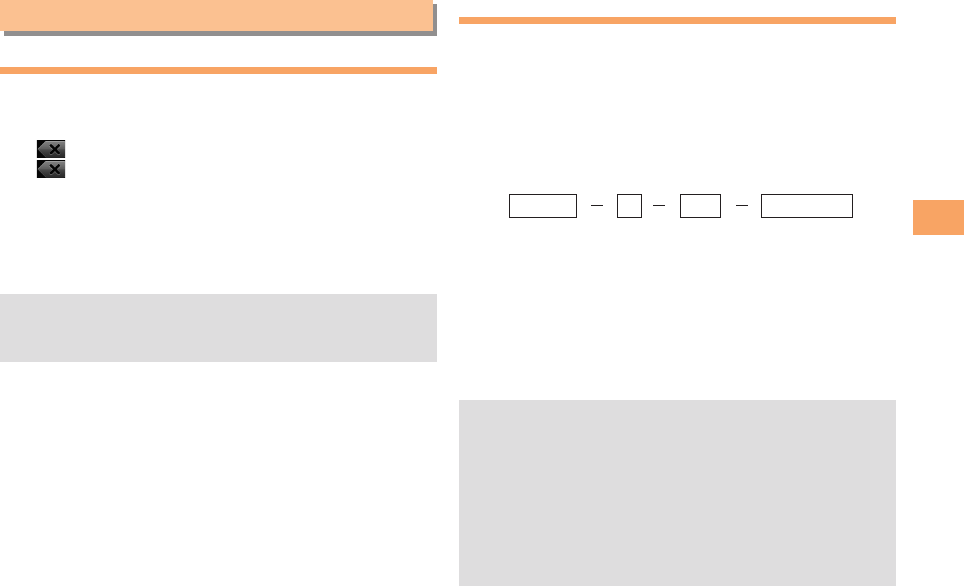
21
Making and Answering Calls
Making and Answering Calls
Making a Call
1 From the Home screen, Phone
2 Enter a phone number.
: Delete a digit of entered numbers
(Long-touch): Delete all numbers
When calling to a fixed-line phone, you also need to
enter the area code.
3 Call → Talk → End
Press m during a call to adjust earpiece volume
(the other party's voice volume).
Add 184 or 186 before entering a phone number to
set whether to inform the other party of your phone
number.
•
•
•
•
Making an International Call
001 International Call Service
Available without any additional application.
Example: To call 212-123-△△△△ in the USA
1 Phone number entry screen → Enter the
access code, a country code, area code, and
phone number → Call.
*1 Long-touching "0" to enter "+" automatically adds
"001010" when dialing.
*2 If the area code begins with "0", omit "0" (there are
some exceptions such as fixed-line phones in Italy and
Moscow).
International call charges are billed together with
monthly local call charges.
For more information on 001 International Call Service,
dial either of the following numbers:
From au cell phones (toll-free):
157 (area code not required)
From fixed-line phones (toll-free):
0077-7-111
(Open 9:00 to 20:00 everyday)
■
•
•
001010
↑
KDDI international
access code*1
↑
Country
code
(USA)
↑
Area code*2
↑
Phone number
212 123
-
XXXX1001010
↑
KDDI international
access code*1
↑
Country
code
(USA)
↑
Area code*2
↑
Phone number
212 123
-
XXXX1
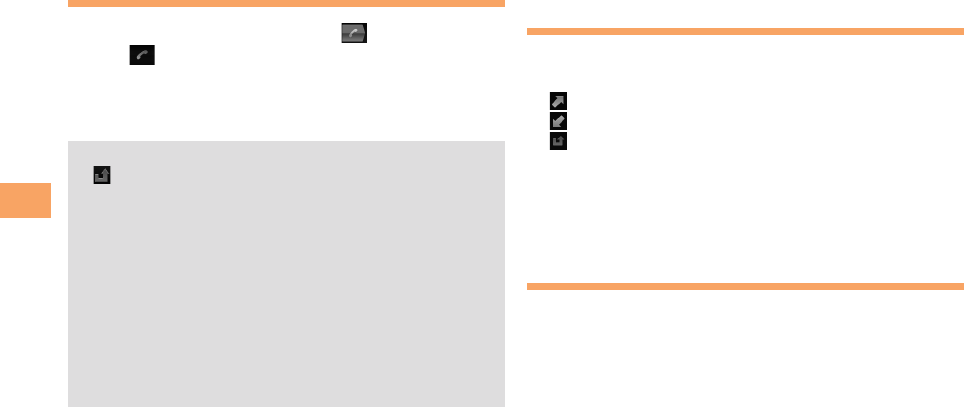
22
Making and Answering Calls
Answering a Call
1 While receiving a call, touch (left) and drag
it to (right).
Start a call.
2 Talk → End call
When the call ends, approximate call charge appears.
When you missed a call
appears in the status bar. Slide the status bar
downward and open the notification panel to view the
receiving time, phone number or name registered in
the Contacts, etc.
To mute the ringtone for an incoming call
Press m or p when a call is received to mute
the ringtone.
If an incoming call is received during use of other
functions
If an incoming call is received during use of Contacts
or Mail, the operation is interrupted and resumes after
call ends.
When you receive an incoming call
When an incoming call is received, the following are
displayed.
If the number of other party is informed, the phone
number appears on the display.
If a name and phone number are stored, the information
such as name, etc. appears. If an image is stored, the
image appears on the display.
•
•
•
•
•
■
•
•
Returning a Call (Outgoing History/
Incoming History)
You can use the call history to make a call.
1 From the Home screen, Phone → Call log
: Calls
: Received calls
: Missed calls
2 Select a history log to make a call.
3 Make a call.
The information to be displayed depends on the type
of call history.
Setting the Silent Mode
1 Settings screen → Sound → Mark Silent mode.
Setting Vibration Mode
1 Settings screen → Sound → Vibrate
2 Always/Never/Only in Silent mode/Only when not in
Silent mode
•
■

23
Making and Answering Calls
Setting a Ringtone
You can set voice file in ".wav", ".m4a" or in other format
which is transferred from Media Go or downloaded from the
Internet as a ringtone.
1 Settings screen → Sound → Phone ringtone/
Notification ringtone
2 Select a ringtone → Done.
Enabling Touch Tones
1 Settings screen → Sound
2 Mark Audible touch tones, Audible selection.
Audible touch tones is a tone for numeric key operations
and Audible selection is a tone when selecting menu item.
If you unmarked them, any operation tone does not sound
when you tap.
To set the key sound of software keyboard, from the
Settings screen → Language & keyboard, and select a
type of software keyboard.
•
•
Adjusting the Sound Volume
1 Settings screen → Sound → Volume
Adjust the volume of following items.
- Ringtone
- Media (sounds of the Music player, Gallery and FM
radio)
- Alarm
- Notification
2 Drag the slider to the right or left to adjust the
volume.
3 OK
•
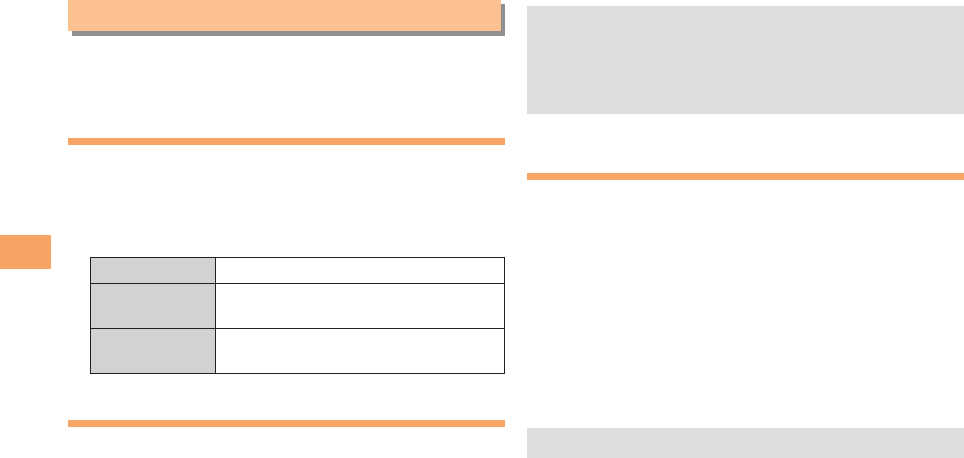
24
Global Function
Global Function
The IS12S supports Global Passport CDMA/GSM services.
You can use your IS12S overseas without any additional
application.
Setting the Area
Set an area where you use the IS12S.
1 From the Home screen, t → Settings →
Wireless & networks → Mobile networks → Global
function → OK → Area setting
2Japan When you use in Japan
Overseas CDMA When you use CDMA network
overseas
Overseas GSM When you use GSM network
overseas
Switching Network Manually
1 From the Home screen, t → Settings →
Wireless & networks → Mobile networks → Global
function → OK → Area setting → Overseas GSM →
OK
2 Network operators → Search mode → Select
manually → Select a network you use.
To display available networks, tap Search networks.•
If you set a network manually, the IS12S is not
reconnected to another network automatically even if
you move out of the network area.
While performing CDMA roaming, manual settings
cannot be made.
Obtaining the Latest PRL
(Preferred Roaming List)
The PRL (Roaming Area Information) contains information
on roaming areas of overseas partner providers who have
signed an international roaming contract with KDDI (au).
Please perform PRL Update before traveling.
1 From the Home screen t → Settings →
Wireless & networks → Mobile networks → Global
function → OK → PRL Update
The PRL is obtained. Download PRL data by following
the on-screen instructions.
When you download the PRL data, packet
communication charges apply.
Please obtain the latest PRL before traveling.
•
•
•
•
•

25
Global Function
Making a Call to Outside Country
You Stay (Including Japan)
You can make a call to Japan or another country from your
travel destination.
1 From the Home screen, Phone
2 + (Long-touch "0") → Enter a country code,
area code (city code), and phone number.
3 Call
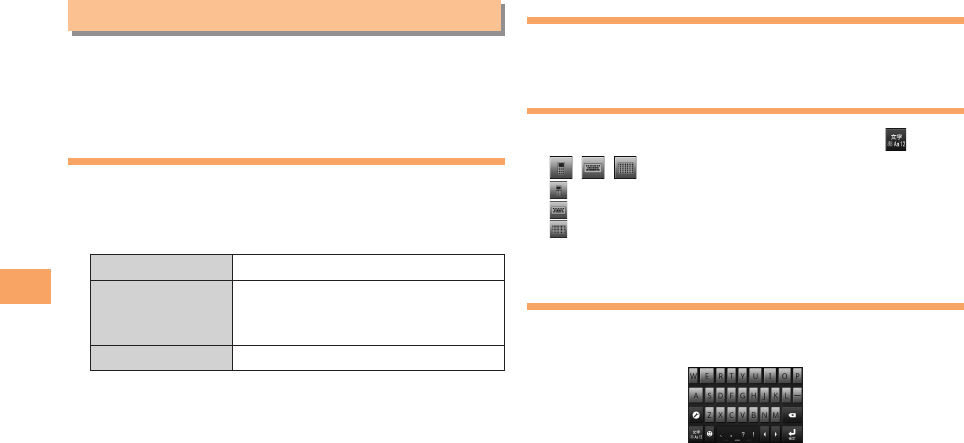
26
Character Input
Character Input
Use the software keyboard to enter characters. To display
the software keyboard, tap a character input box in the
character entry screen for adding contacts, creating a
message, etc.
Selecting Input Method
You can select an input method (keyboard type) for IS12S.
1 Character entry screen → Long-touch the entry
field → Input method.
2Chinese keyboard Select to enter Chinese.
Default input Select a language for text entry.
Select to enter language other
than Japanese.
Japanese keyboard Select to enter Japanese.
Software Keyboard
For Japanese keyboard, there are three types of software
keyboards: QWERTY, 12 key and Japanese syllabary.
Switching the Keyboard
1 Character entry screen → Long-touch .
2 / /
: The 12 key keyboard appears.
: The QWERTY keyboard appears.
: The Japanese syllabary keyboard appears.
Entering Characters on the
QWERTY Keyboard
Japanese characters can be entered in "Romaji input"
mode.
<QWERTY keyboard>
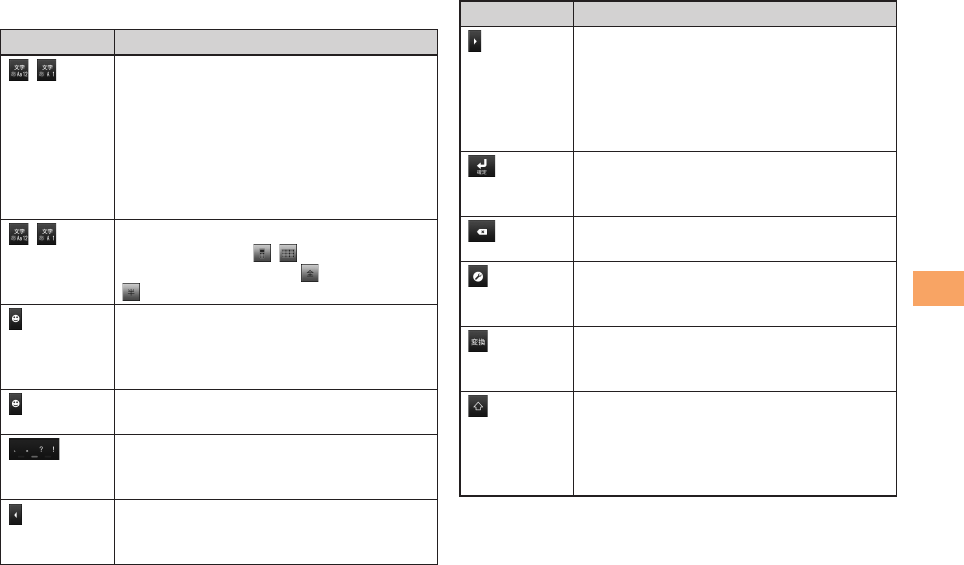
27
Character Input
Main Functions of the Touch-Keys
Icon Description
/ Each time you tap, the character mode
switches Number → Hiragana/Kanji →
Alphabet in order.
あ: Hiragana/Kanji
Aa: Double-byte alphabet/A: Double-
byte alphabet
12: Single-byte number/1: Double-byte
number
/
(Long-touch)
Display a character mode switch window.
Keyboard switch: /
Character mode switch: (Double-byte),
(Single-byte)
Each time you tap, the character mode
switches Pictograms (only for C-mail)
→ Single-byte symbols → Double-byte
symbols → Smileys in order.
(Long-touch)
A list of plug-in applications appears and
you can activate the plug-in application.
Symbol assistant area: Enter “、。?!”.
Flick from side to side to enter a space,
・, ~, …, 「, 」, (, and ).
Move the cursor*1 to the left. Long-touch
to move continuously. Or change the
range for conversion.
■Icon Description
Move the cursor*1 to the right. Long-touch
to move continuously. Or change the
range for conversion. When there is an
unfixed character string with the cursor
at the right end, tap to enter the same
character as the one at the end.
*2Fix entered or converted characters.
When characters are already fixed, enter
a line feed at the cursor position.
Delete the character before the cursor.
Long-touch to delete continuously.
Appears in Japanese (Romaji) input
mode. Make settings of Change settings
and Input Method.
Appears before conversion is fixed to
switch conversion method to direct
conversion.
In alphanumerics input mode, tap to
switch upper case and lower case.
In number input mode, tap to switch
symbols possible to enter with the
keyboard.
*1 When any characters are entered, just tap the desired
position on the entered character string to move the
cursor.
*2 In some screens such as the search box or mail account
registration screen,
次へ
(Next),
完了
(Done),
実行
(Execute), etc. appear.
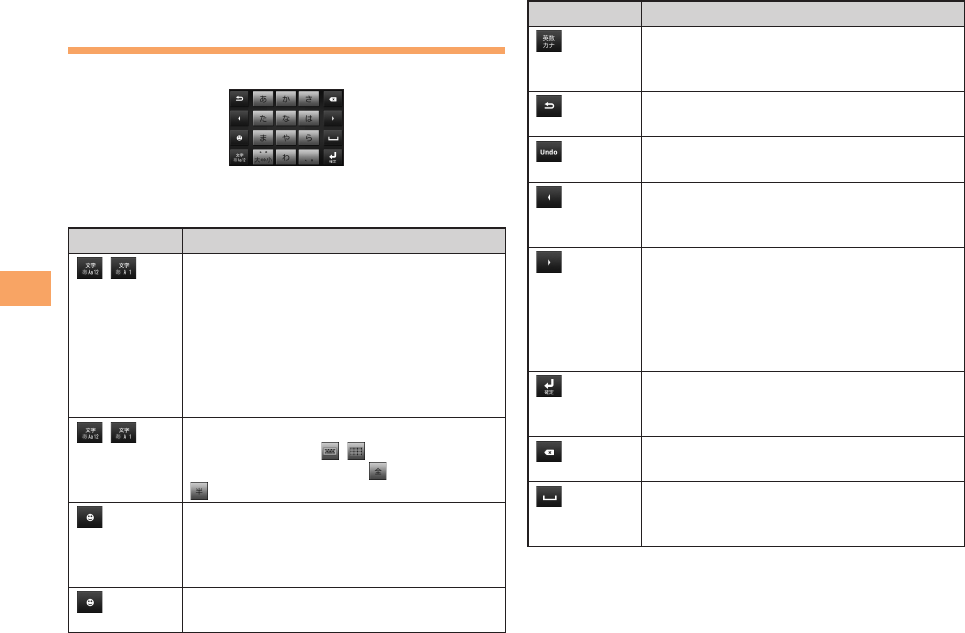
28
Character Input
Entering Characters on the 12 key
Keyboard
Japanese characters can be entered in Kana input mode.
<12 key keyboard>
Main Functions of the Touch-Keys
Icon Description
/ Each time you tap, the character mode
switches Number → Hiragana/Kanji →
Alphabet in order.
あ: Hiragana/Kanji
Aa: Single-byte alphabet/A: Double-byte
alphabet
12: Single-byte number/1: Double-byte
number
/
(Long-touch)
Display a character mode switch window.
Keyboard switch: /
Character mode switch: (Double-byte),
(Single-byte)
Each time you tap, the character mode
switches Pictograms (only for C-mail)
→ Single-byte symbols → Double-byte
symbols → Smileys in order.
(Long-touch)
A list of plug-in applications appears and
you can activate the plug-in application.
■
Icon Description
Appears before conversion is fixed
to switch conversion methods (Word
suggestion, Direct conversion).
Display the previous character (opposite
order).
Appears after conversion is fixed to return
to text before conversion.
Move the cursor*1 to the left. Long-touch
to move continuously. Or change the
range for conversion.
Move the cursor*1 to the right. Long-touch
to move continuously. Or change the
range for conversion. When there is an
unfixed character string with the cursor
at the right end, tap to enter the same
character as the one at the end.
*2Fix entered or converted characters.
When characters are already fixed, enter
a line feed at the cursor position.
Delete the character before the cursor.
Long-touch to delete continuously.
Display the first candidate of direct
conversion. When any character is
entered, a space can be entered.
*1 When any characters are entered, just tap the desired
position on the entered character string to move the
cursor.
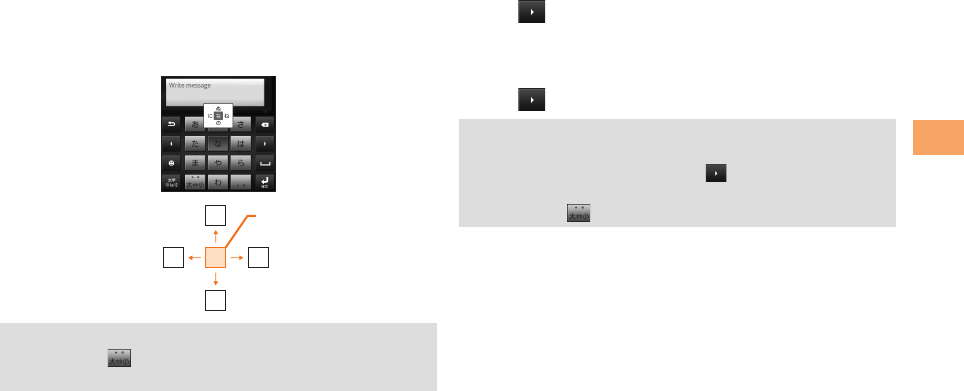
29
Character Input
*2 In some screens such as the search box or mail account
registration screen,
次へ
(Next),
完了
(Done),
実行
(Execute), etc. appear.
Flick input
Flick up/down/left/right to enter characters in each column
of kana syllabary. Characters can be entered without
repeatedly tapping the key.
Example: Entering characters in "な" column
You can enter "な" only by tapping. Flick left for "に", up for
"ぬ", right for "ね" and down for "の".
ぬ
ねに
の
な
Flick left
Flick up Touch a key
Flick right
Flick down
To switch upper/lower case or change to voiced
sound, tap .
Flick input is set to on by default.
■
•
•
Toggle entry
Tap the same key continuously to enter the assigned
character. To enter characters assigned to the same key
continuously, operate the followings.
Example: Entering "あお"
1 Tap
あ
once.
2 Tap , and tap
あ
five times.
Example: Entering "ca"
1 Tap ABC three times.
2 Tap , and tap ABC once.
When a certain time is passed after the key tapped,
you can enter a character assigned to the same key
consecutively without tapping .
To switch upper/lower case or change to voiced
sound, tap .
■
•
•
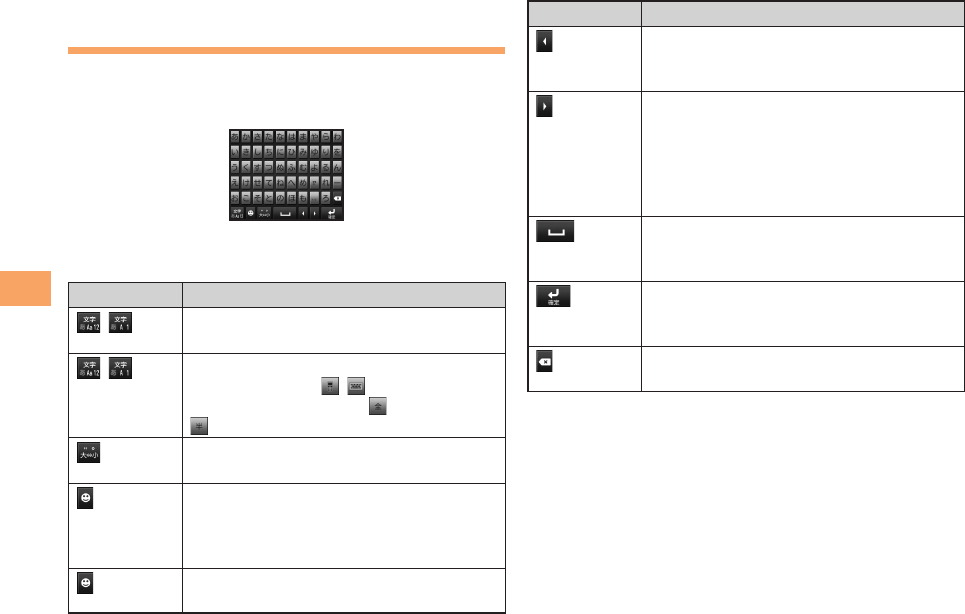
30
Character Input
Entering Characters on the
Japanese Syllabary Keyboard
You can use the software keys arranged according to the
Japanese syllabary to enter Japanese characters in Kana
input mode.
<Japanese syllabary keyboard>
Main Functions of the Touch-Keys
Icon Description
/ Tap to switch the character mode
between Hiragana/Kanji and Number.
/
(Long-touch)
Display a character mode switch window.
Keyboard switch: /
Character mode switch: (Double-byte),
(Single-byte)
Tap to switch upper/lower case or add
voiced sound.
Each time you tap, the character mode
switches Pictograms (only for C-mail)
→ Single-byte symbols → Double-byte
symbols → Smileys in order.
(Long-touch)
A list of plug-in applications appears and
you can activate the plug-in application.
■
Icon Description
Move the cursor*1 to the left. Long-touch
to move continuously. Or change the
range for conversion.
Move the cursor*1 to the right. Long-touch
to move continuously. Or change the
range for conversion. When there is an
unfixed character string with the cursor
at the right end, tap to enter the same
character as the one at the end.
Display the first candidate of direct
conversion. When any character is
entered, a space can be entered.
*2Fix entered or converted characters.
When characters are already fixed, enter
a line feed at the cursor position.
Delete the character before the cursor.
Long-touch to delete continuously.
*1 When any characters are entered, just tap the desired
position on the entered character string to move the
cursor.
*2 In some screens such as the search box or mail account
registration screen,
次へ
(Next),
完了
(Done),
実行
(Execute), etc. appear.
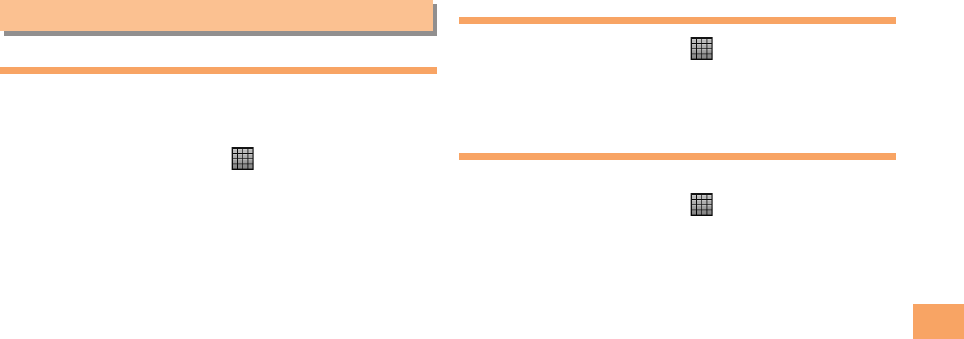
31
Contacts
Contacts
Saving a Contact
In the Contacts application, you can enter your information
for your personal contacts, for example, phone numbers,
mail addresses and web service accounts.
1 From the Home screen, → Contacts
The first time you open Contacts, a setup wizard
starts. In the setup wizard, you can load contacts from
microSD memory card, or synchronize your Google
account and the IS12S contacts.
To use Contacts, tap Open phonebook.
2 t → New contact
3 Phone contact/(Google Account)
If you have not set a Google account, Phone contact
appears as the saving location.
4 Enter a name.
5 Enter other information as required.
You can enter phone numbers, mail address, ringtone,
etc. You can add items by tapping Add field.
6 Done
•
•
•
•
Dialing from the Contacts
1 From the Home screen, → Contacts
2 Tap the contact.
3 Tap the phone number.
Editing Contacts
You can edit saved contacts.
1 From the Home screen, → Contacts
2 Tap the contact.
3 Edit
4 Select an item to edit.
5 Done

32
Mail
Mail
With IS12S, you can use the following types of mail.
C-mail
C-mail is a service that uses phone numbers as addresses
to send or receive messages between cell phones.
PC-mail
By using Email application, you can create an email
account such as an au One email account, an Exchange
ActiveSync account, a POP3 or IMAP compatible email
account provided by general service provider, etc. to send
and receive email like a PC.
If you subscribe au One mail service, you can receive an
email whose address is XXX@ezweb.ne.jp by using Email
application.
Gmail
Gmail is a mail service provided by Google. You can check,
send and receive Gmail from the IS12S.
■
■
■
Using C-mail
C-mail is a service that uses phone numbers as addresses
to send or receive messages between cell phones.
C-mail Safety Block
C-mail safety block is a function that allows you to reject
C-mails that include URLs (http://△△△, https://△△△) or
phone numbers in the C-mail message text.
C-mail safety block is valid by default. Cancel the setting if
you want to receive C-mails that include URLs and phone
numbers in the message text.
Creating and Sending C-mail Messages
You can send a message (message text) consisting of kanji,
hiragana, katakana, alphanumerics, symbols, pictograms
and face marks. After sending, you can know whether the
message has been sent to the other party.
1 From the Home screen, → C-mail
2 New message
3 Add recipient → Select a recipient you want to
send a message from the contact list or enter a
phone number.
4 Write message → Enter a message text.
5 Send
■
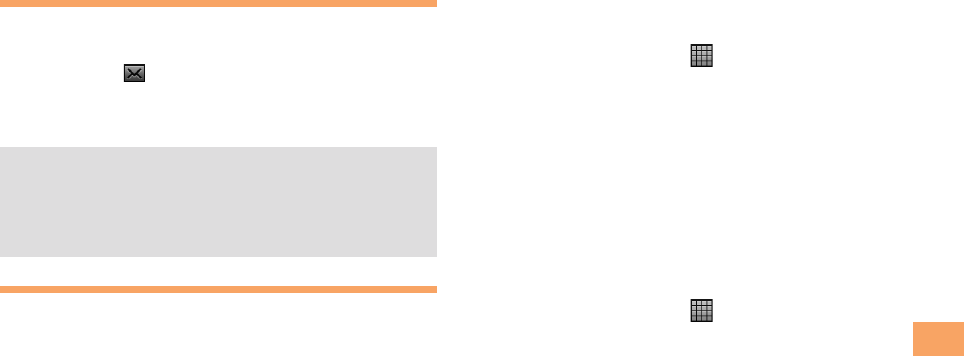
33
Mail
Reading Received C-mail Messages
1 Receive C-mail.
When receiving C-mail from the C-mail center is
completed, appears in the status bar.
2 Slide the status bar downward.
3 Tap the C-mail information you want to check.
C-mail is available for only receiving overseas.
There is no charge for receiving C-mail.
Deactivate C-mail safety block setting to receive
C-mails that contain phone numbers or URLs in the
message text.
Using PC-mail
By using Email application, you can create an email
account such as an au One email account, an Exchange
ActiveSync account, a POP3 or IMAP compatible email
account provided by general service provider, etc. to send
and receive email like a PC.
You need to set up a PC-mail account beforehand to use
PC-mail.
You need to set up au one mail beforehand to use au one
mail with Email application.
Setting a PC-mail Account
When you use PC-mail for the first time, set up a PC-mail
account.
If you need to make the settings manually, contact your
PC-mail service provider or system administrator for the
correct PC-mail account settings.
•
•
•
•
•
•
■
•
If you set an Exchange ActiveSync account as PC-mail
account, and if server manager sets Remote wipe, the
data saved in the IS12S may be deleted.
1 From the Home screen, → Email
2 Enter your PC-mail address and password.
3 Next
4 Give this account a name → Enter an account
name.
5 Your name → Enter your name.
6 Done
Registering Another PC-mail Account
You can add an account to register.
1 From the Home screen, → Email
The Email screen appears. When other than the Email
screen appears, t → Accounts to display the Email
screen.
2 t → Add account
3 Enter your PC-mail address and password.
4 Next
5 Give this account a name → Enter an account
name.
6 Your name → Enter you name.
7 Done
•
■
•

34
Mail
Sending PC-mail Messages
1 Email screen → New mail
2 To → Enter a recipient.
3 Subject → Enter a subject.
4 Enter a message text.
5 If necessary, Add attachment → Select an
operation.
You can select attachment files from Add picture, Take
photo, Add video, etc. Up to 5 MB of images, movies,
music files can be attached.
6 Send
Receiving PC-mail Messages
1 Email screen → Tap the PC-mail account with
which you want to receive mail.
2 t → Refresh
3 Tap an email.
Saving Email Message Attachment
1 Slide an email message with an attachment
downward.
2 Tap Save for a file you want to save.
■
•
■
■
Using Gmail
Gmail is a mail service provided by Google. You can check,
send and receive Gmail from the IS12S.
You need a Google account to use Gmail. For detailed
information, see "Setting Google Account" (P.11).
Gmail contacts are synchronized with the IS12S contacts.
For details on how to use etc., Gmail Inbox → t →
more → Help to check Google Mobile Help.
Gmail messages are not displayed in Timescape.
Starting Gmail
1 From the Home screen, → Gmail
t → labels to display the Labels screen listing
Inbox, Outbox, etc.
Refreshing Gmail
You can refresh the Inbox by synchronizing Gmail
application in the IS12S with your Gmail account.
1 From the Home screen, → Gmail
2 t → Refresh
•
•
•
•
■
•
■
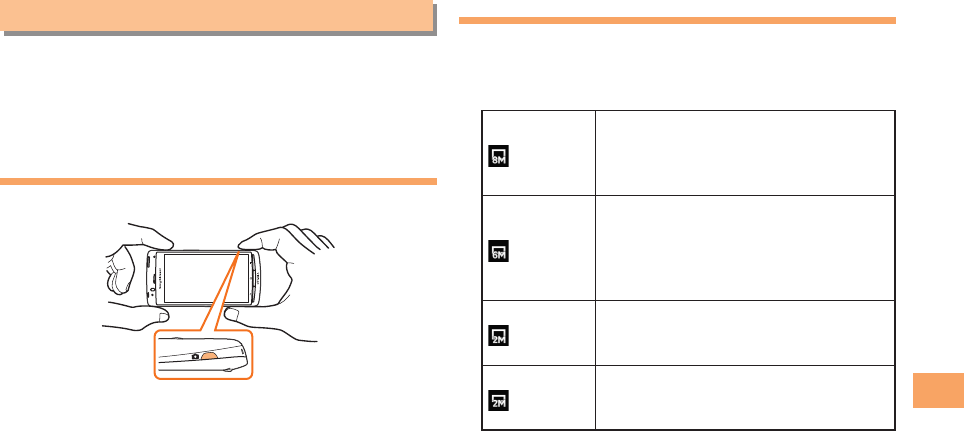
35
Camera
Camera
You can take a photo or record a movie either by tapping
the screen or by using the camera key (k). You can
hold the camera horizontally or vertically to take a photo.
For recording movies, screen display supports landscape
only.
Photo Taking Tips
Hold the cell phone steady with both hands when shooting.
Setting Image Size for Photo
Select image size and aspect ratio. An image with a higher
resolution requires more memory.
1 Photo monitor screen → t → Resolution
2
8MP 4:3
8 megapixel image size with 4:3
aspect ratio. Suitable for viewing on
normal size screen or printing in high
resolution.
6MP 16:9
6 megapixel image size with 16:9
aspect ratio. Compatible with a high
resolution wide-screen format. A
higher resolution than full HD. Suitable
for viewing on wide-screen.
2MP 4:3
2 megapixel image size with 4:3
aspect ratio. Suitable for viewing on
normal size screen.
2MP 16:9
2 megapixel image size with 16:9
aspect ratio. Suitable for viewing on
wide-screen.
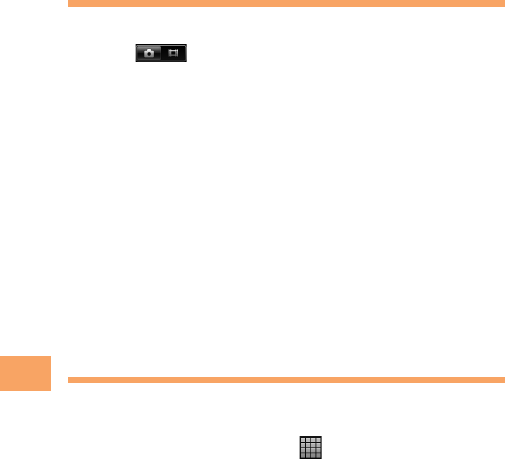
36
Camera
Taking a Photo
1 k (hold down for at least one second)
Tap to switch between the photo monitor
screen and movie monitor screen.
m: Zoom in/out
2 k
Shutter clicks and the shot image is automatically
saved in the microSD card.
Recorded images are displayed as thumbnails on the
photo monitor screen. Tap a thumbnail to display the
photo.
Tapping a Screen to Shoot
If Touch capturing is set to on, you can directly tap the
screen to shoot.
1 Photo monitor screen → Tap the screen.
Viewing Photos (Gallery)
Photos and movies that you took or saved in the microSD
from a PC are displayed in an album.
1 From the Home screen, → Gallery
2 Tap an album.
3 Tap a data.
•
•
•
■

37
Web Browser
Web Browser
Viewing Sites with Web Browser
You can use a browser to view web pages just as you can
on a PC.
Displaying a Web Page
1 From the Home screen, Browser
You can view the browser screen turning the IS12S
sideways. If the screen orientation does not change
automatically when you turn the IS12S sideways, from
the Home screen, t → Settings → Display, then
mark Auto-rotate screen.
Browser screen → t → More → Settings → Mark
Landscape-only display to fix the landscape view.
Basic Operations in the Browser
Screen
The following operations are available.
Tap: Selects or activates a link or a key.
Slide/Flick: Scrolls a screen.
Pinch out/in: Zooms in/out on a screen.
Double tap: Zooms in/out on a tapped point (depending
on the web pages, some operations may not be
available).
: Zoom out
: Zoom in
•
•
■
•
•
•
•
•
•
Moving to a Web Page
1 Browser screen → Tap the search box.
2 Enter URL or search keywords.
3 Select an item from the list/ [ ] in the search
box.
4 To return to the previous page, press x.
Using Windows
You can open new windows while browsing. Up to 8
windows can be opened.
Opening a New Browser Window
1 Browser screen → t → New window
Switching the Windows
1 Browser screen → t → Windows
2 Tap a window you want to display.
Closing a Browser Window
1 Browser screen → t → Windows
2 for a window you want to close.
Searching for Text within a Web Page
1 Browser screen → t → More → Find on page
■
■
■
■

38
Web Browser
2 Enter search keywords in the search bar.
As you enter, matching characters are highlighted in
green.
3 to return to the previous matched item/
to go to the next matched item.
4 to close the search bar.
Copying Text within a Web Page
1 Browser screen → t → More → Select text
2 Place your finger at the start of the text you
want to copy and then drag to the end of the
text you want to copy.
Copied text is highlighted in orange.
3 Take your finger away from the screen and tap
the selected text.
Downloading Images within a Web
Page
1 Browser screen → Long-touch an image/a link
containing images.
The links get enclosed in an orange box.
2 Save image
Downloaded images can be checked in the following
steps: From the Home screen, → Gallery →
Download, or Browser screen → t → More →
Downloads
•
■
•
■
•
•
Using Bookmarks/History
You can check browser history and save bookmarks.
1 Browser screen → t → Bookmarks
2 Tap a bookmark you want to open.
Storing Bookmarks
1 Browser screen → t → Bookmarks
■ Thumbnail view
2
★
Add → Rename bookmark as required → OK.
■ List view
2 Add bookmark... → Rename bookmark as
required → OK.
Checking History
1 Bookmark screen → History
2 Tap the time you browsed the web page, such
as Today, Yesterday, etc.
3 Tap a URL you want to check.
Clearing History
1 Bookmark screen → History
2 t → Clear history
The bookmark list in "Most visited" is also deleted when
deleting the history.
■
■
■
•
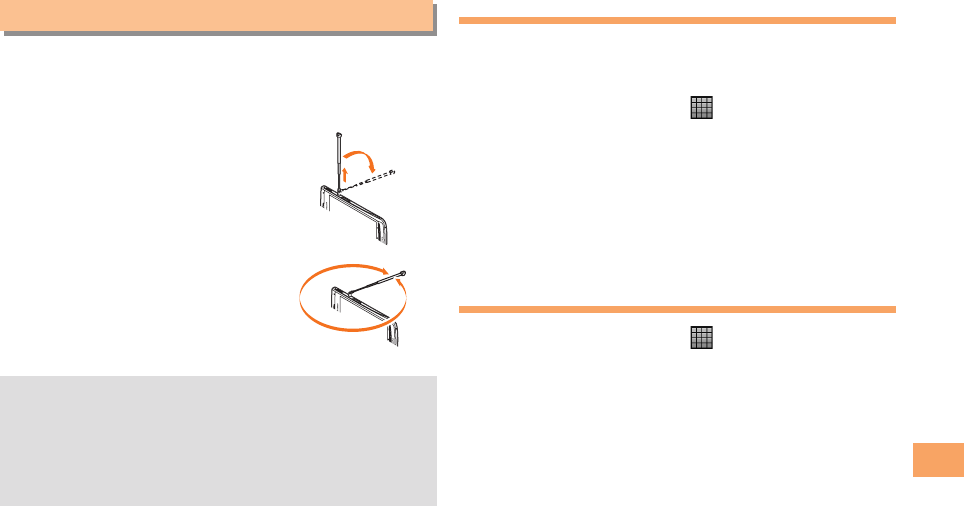
39
TV (1Seg)
TV (1Seg)
"1Seg", a mobile terrestrial digital television service in
Japan, is available on the IS12S.
Using the TV Antenna
Extend the antenna to receive
stronger airwaves, when watching
TV (1Seg).
Stretch out the whip antenna until
it stops.
Whip antenna can be rotated by
360 degrees. Use the antenna in
the direction you can receive a
stronger airwaves.
If you are watching TV indoors, you may be able to
improve the reception by moving closer to a window.
For information about the "1Seg" service, refer to the
following homepage.
The Association for Promotion of Digital Broadcasting.
http://www.dpa.or.jp/
■
•
•
Initial Setup of the TV (1Seg)
Make channel setting when you activate 1Seg for the first
time. After setting is complete, you can watch TV (1Seg)
programs.
1 From the Home screen, → 1Seg
2 Channel setting → Select area → Select current
location → YES.
On the channel setting screen, tap Current area to start
channel scan.
When the scan is complete, YES → Enter a title for the
channel list → YES.
Press x to return to the 1Seg menu screen.
Watching TV (1Seg)
1 From the Home screen, → 1Seg
2 Activate 1Seg
Tap the image to temporarily view program information
such as channel, broadcast station name, program
name, multi-channel formation (multiple services), etc.
Press t on the 1Seg watching screen to display
operation bar.
•
•
•
•
•

40
TV (1Seg)
Basic Operations
Switching orientation
Portrait and landscape display are switched according
to the orientation of the cell phone. Data broadcasting is
displayed when in the portrait display mode.
Volume adjustment
Use m to adjust volume.
Switching channels
Flick the video image to the left/right to switch channels.
Exit 1Seg
Press x while watching 1Seg.

41
Applications
Applications
Using Android Market
With Android Market, you can directly access to useful
applications or games, which you can download and install
on the IS12S. And you can send feedback and comments
about an application, or report objectionable application or
incompatible application with the IS12S as an inappropriate
content.
To use Android Market, you need to set a Google
account. For detailed information, see "Setting Google
Account" (P.11).
Some applications or games you can download are
charged. You can check which application is charged or
free on the applications list on the market . For details on
how to purchase a charged application, return and refund
policy, etc., refer to "Android Market Help".
Before Using Android Market
Make sure to check the security of application, then install
it at your own risk. The cell phone may be infected with a
virus and the data may be damaged, depending on the
application.
KDDI shall not be liable for any malfunctions, if any,
caused by the application you installed. In such case, the
repair is charged even during the warranty period.
KDDI shall not be liable for any disadvantage brought to
you or any third party due to an application you installed.
•
•
■
•
•
•
Some applications automatically perform packet
communications. Packet communication is kept active
unless you disconnect it or the time-out is occurred. To
disconnect packet communication manually, from the
Home screen, t → Settings → Wireless & networks →
Mobile networks, then unmark Data enabled.
Some applications may be updated automatically.
Viewing Android Market
1 From the Home screen, Market
When you open Android Market for the first time, the
Terms of Service for Android Market appears. Tap Accept.
Android Market Help
When you need help or have any questions about Android
Market, press t, then tap Help. From the Browser, open
the Android Market Help web page.
Managing Applications
You can display installed applications on the screen or
change settings. Many applications contain wizards for
supporting the installation.
Downloading Unknown Source's
Application
Before you can download unknown source's applications,
set the IS12S to enable downloading. Applications you
download may be of unknown origin. To protect the IS12S
and personal data, only download applications from trusted
sources such as the Android Market etc.
•
•
■
•
■
■

42
Applications
1 Setting screen → Applications → Mark Unknown
sources.
2 Read the cautions appeared → OK.
Deleting Installed Applications
Before deleting installed applications, back up contents
related to the application that you want to save including
data saved in the application.
Some applications cannot be deleted.
1 Settings screen → Applications → Manage
applications
2 Tap an application to uninstall.
3 Uninstall
4 OK
■
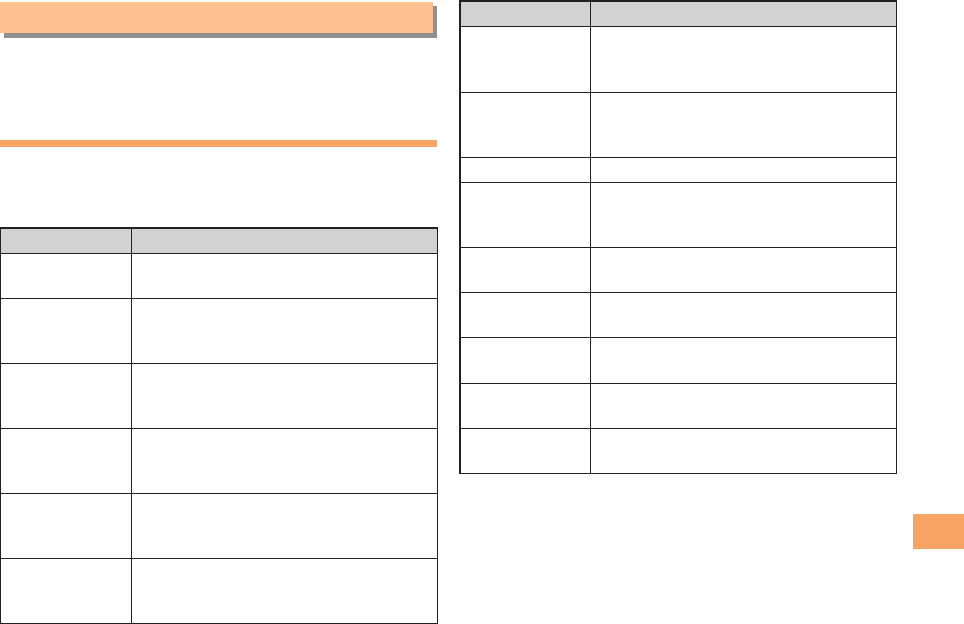
43
Viewing the Setting Menu
Viewing the Setting Menu
From Settings, set up and manage IS12S functions. You
can personalize the wall paper or ringtone, set up security,
initialize data, etc.
Starting the Setting Menu
1 From the Home screen, t → Settings
Setting Menu List
Item Setting
Sony Ericsson Connect the IS12S to another device or
PC via USB connection or Wi-Fi.
Wireless &
networks
Make communication settings such
as Airplane mode, Wi-Fi, Bluetooth®,
Mobile networks etc.
Call settings
Set network services such as
Answering Service (Voice Mail), Call
Transfer, etc.
Sound
Set Silent mode, adjust volume for
call ringtone, mail ringtone, key touch
tones, Vibration, playback, etc.
Display
Make display settings such as Mobile
BRAVIA Engine, Animation, Auto-rotate
screen, Screen timeout.
Location &
security
Make location settings such as enable/
disable the GPS function, or security
settings such as screen lock.
■
Item Setting
Applications
Make settings for installing or activating
applications. And manage installed
applications.
Accounts & sync
Make basic settings for managing
online service accounts or
synchronizing data.
Privacy Restore the default settings.
Storage
Check memory space of microSD
memory card and the IS12S, and
initialize microSD memory card.
Language &
keyboard
Set the display language and make
character entry settings.
Voice input &
output
Make Google voice recognizer settings
and Text-to-speech settings.
Accessibility Set call end operation and user support
service.
Date & time Set date and time, date & hour format
etc.
About phone Check your own phone number, signal
level, etc. Perform software update.
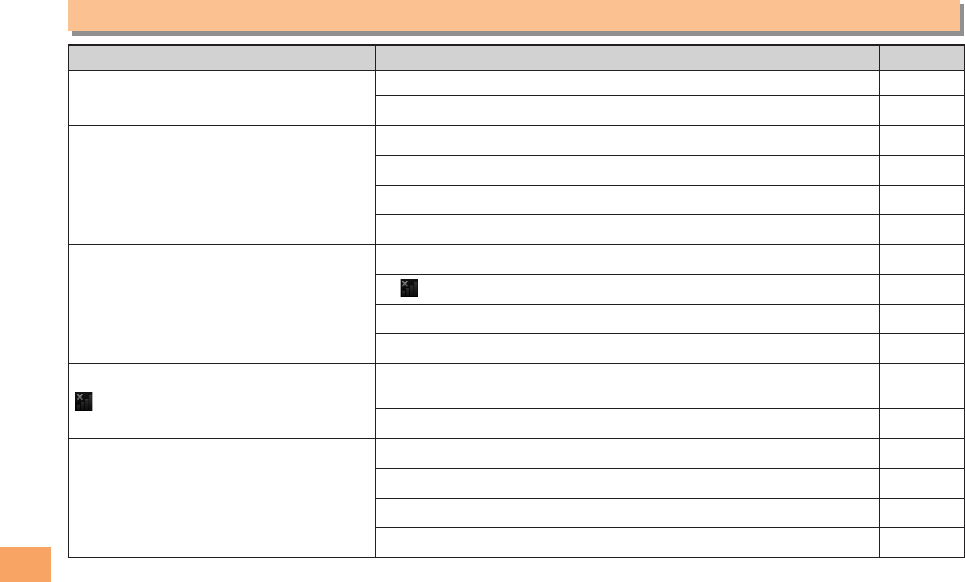
44
Troubleshooting
Troubleshooting
Symptom Possible Cause/Remedy Page
Cannot turn on power by pressing p.Is the battery pack charged? 9
Did you hold down p for at least one second? 10
Cannot make calls.
Is power tuned on? 10
Did you enter the phone number starting with the area code? 21
Did you tap Call after entering phone number? 21
Is "Airplane mode" set? 16
Cannot receive calls.
Is signal strong enough? 16
Is (out of range indicator) displayed? 16
Is power tuned on? 10
Is "Airplane mode" set? 16
(out of range indicator) appears.
Are you out of the service area or in a location where the signal is
too weak? 16
Are you covering the built in antenna area with fingers, etc.? 7
Key/Touch panel operation is disable.
Is power tuned on? 10
Is the key lock set? 10
Turn power off and on. -
Press p/y to turn on the backlight. -
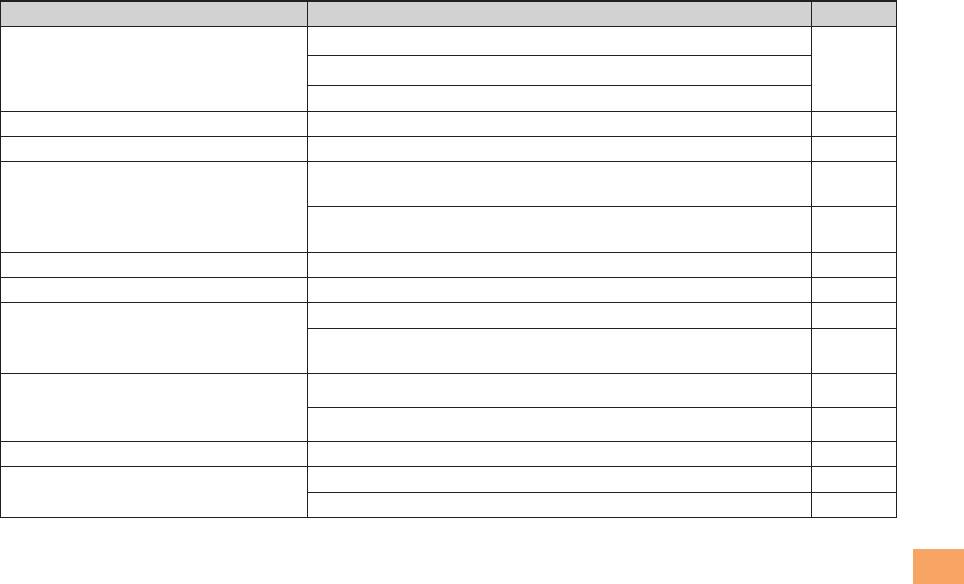
45
Troubleshooting
Symptom Possible Cause/Remedy Page
Cannot operate the touch panel as
intended.
Make sure the way to operate the touch panel.
13
Are you operating with gloved hands?
Are you operating with a fingernail or foreign object on the screen?
A warning to charge appears. The battery is almost exhausted. 9
Calls are answered automatically. Is Silent mode set? 22
A beep sound is heard from the
earpiece and a connection cannot be
made when making a call.
Are you out of the service area or in a location where the signal is
too weak? 16
Wireless line ins busy or the other party is on another line. Try
again later. -
Screen backlight goes off in a moment. Is set Screen timeout period too short? 43
The display is dim. Is set screen brightness too dark? 43
Cannot hear the other party.
Is the earpiece volume too low? 21
Are you covering the earpiece with your ear? Place your earhole to
the earpiece. 7
1Seg watching is unavailable, image
stops, sounds stop, 1Seg generates
noise.
Did you extend the whip antenna? 39
Are you in the area which you selected in Select area? 39
Cannot create PC-mail. Did you set up a PC-mail account? 33
Cell phone does not recognize the
microSD memory card.
Is microSD memory card inserted correctly? 12
Is microSD card unmounted? 12
For more detailed information, visit the following au troubleshooting sites:
- From a PC: http://www.kddi.com/customer/service/au/trouble/kosho/index.html
•
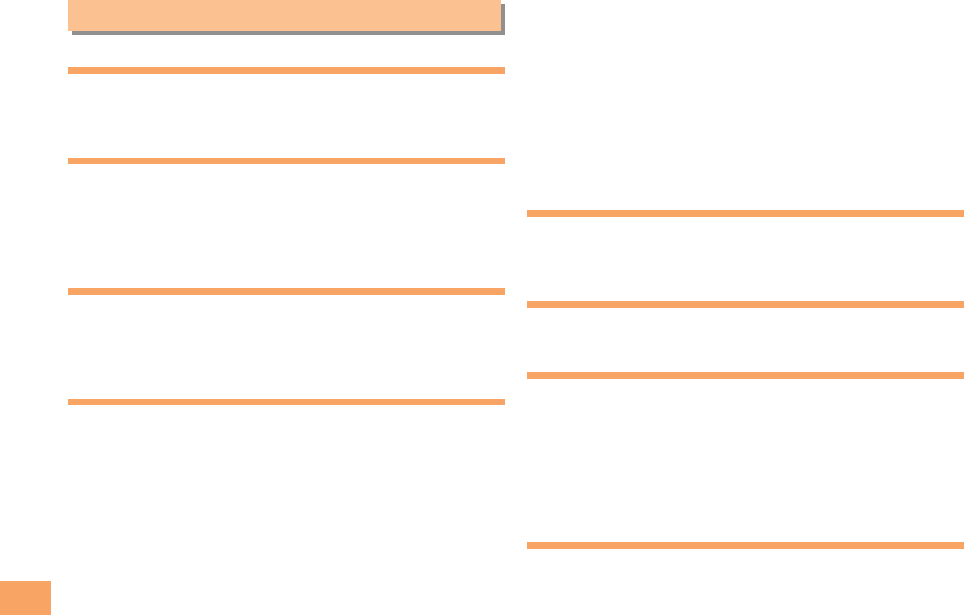
46
Index
Index
Numeric
12 key keyboard …………………………………………… 28
1Seg ………………………………………………………… 39
A
Accessories …………………………………………………… 6
Android Market ……………………………………………… 41
Applications ………………………………………………… 41
Applications screen ………………………………………… 18
B
Battery pack ………………………………………………… 6
,
9
Battery pack cover …………………………………………… 7
Bookmarks ………………………………………………… 38
C
C-mail ………………………………………………………… 32
C-mail safety block ……………………………………… 32
Creating and sending …………………………………… 32
Reading …………………………………………………… 33
Received mail …………………………………………… 33
Call …………………………………………………………… 21
Answering ………………………………………………… 22
History……………………………………………………… 22
Making……………………………………………………… 21
Camera ……………………………………………………… 35
Taking a photo …………………………………………… 36
Viewing photos …………………………………………… 36
Character input ……………………………………………… 26
Charging the battery pack …………………………………… 9
Contacts ……………………………………………………… 31
Dialing……………………………………………………… 31
Editing……………………………………………………… 31
Saving……………………………………………………… 31
D
Display ………………………………………………………… 7
Display language …………………………………………… 11
E
Email ……………………………………………………… 18
,
33
G
Gallery ……………………………………………………… 36
Global Function……………………………………………… 24
Obtaining the Latest PRL (Preferred Roaming List) … 24
Setting the Area…………………………………………… 24
Gmail ………………………………………………………… 34
Google account……………………………………………… 11
H
Home screen ……………………………………………… 15
,
17

47
Index
I
Icons ………………………………………………………… 15
Incoming history …………………………………………… 22
Initial settings ……………………………………………… 11
International call …………………………………………… 21
J
Japanese syllabary keyboard ……………………………… 30
K
Key lock ……………………………………………………… 10
L
Language …………………………………………………… 11
M
Mail …………………………………………………………… 32
C-mail……………………………………………………… 32
Email ……………………………………………………… 33
Gmail ……………………………………………………… 34
PC-mail …………………………………………………… 33
Menu options ………………………………………………… 14
microSD memory card ……………………………………… 12
Myself ………………………………………………………… 11
N
Names of parts ………………………………………………… 7
Notification icons …………………………………………… 15
Notification LED …………………………………………… 16
Notification panel …………………………………………… 17
O
Outgoing history …………………………………………… 22
Own phone number ………………………………………… 11
P
Passwords ……………………………………………………… 3
PC-mail ……………………………………………………… 33
Phone (call) ………………………………………………… 21
184/186 …………………………………………………… 21
Answering ………………………………………………… 22
International Call ………………………………………… 21
Making……………………………………………………… 21
Returning ………………………………………………… 22
Photos ……………………………………………………… 35
Taking……………………………………………………… 36
Viewing …………………………………………………… 36
PIN code ……………………………………………………… 3
Q
QWERTY keyboard ………………………………………… 26

48
Index
R
Ringtone……………………………………………………… 23
S
Security code ………………………………………………… 3
Setting menu ………………………………………………… 43
Silent mode ………………………………………………… 22
Sound volume ……………………………………………… 23
Status bar …………………………………………………… 15
Status icons ………………………………………………… 16
T
Touch Panel ………………………………………………… 13
Basic operations ………………………………………… 13
Troubleshooting …………………………………………… 44
Turning on/off power ……………………………………… 10
TV (1Seg) …………………………………………………… 39
Antenna …………………………………………………… 39
Basic operations ………………………………………… 40
Initial settings……………………………………………… 39
W
Web browser ………………………………………………… 37

49
Radio Wave Exposure and Specific
Absorption Rate (SAR) Information
★Mobile Phone GSM/GPRS/EDGE 850/900/1800/1900&
UMTS/HSPA Bands1/5
United States & Canada
THIS PHONE MODEL HAS BEEN CERTIFIED IN COMPLIANCE
WITH THE GOVERNMENT’S REQUIREMENTS FOR
EXPOSURE TO RADIO WAVES.
The IS12S mobile phones have been designed to comply
with applicable safety requirements for exposure to radio
waves. Your wireless phone is a radio transmitter and
receiver. It is designed to not exceed the limits* of exposure
to radio frequency (RF) energy set by governmental
authorities. These limits establish permitted levels of RF
energy for the general population. The guidelines are based
on standards that were developed by international scientific
organizations through periodic and thorough evaluation of
scientific studies. The standards include a safety margin
designed to assure the safety of all individuals, regardless
of age and health.
The radio wave exposure guidelines employ a unit of
measurement known as the Specific Absorption Rate
(SAR). Tests for SAR are conducted using standardized
methods with the phone transmitting at its highest
certified power level in all used frequency bands. While
there may be differences between the SAR levels of
■
various phone models, they are all designed to meet the
relevant guidelines for exposure to radio waves. For more
information on SAR, please refer to the safe and efficient
use chapter in the User Guide.
The highest SAR value as reported to the authorities for this
phone model when tested for use by the ear is 1.20 W/kg*,
and when worn on the body is 0.79 W/kg* for speech and
1.26 W/kg* for data calls. Body worn measurements are
made while the phone is in use and worn on the body with
a Sony Ericsson accessory supplied with or designated for
use with this phone. It is therefore recommended that only
Ericsson and Sony Ericsson original accessories be used in
conjunction with Sony Ericsson phones.
**Before a phone model is available for sale to the public
in the US, it must be tested and certified by the Federal
Communications Commission (FCC) that it does not
exceed the limit established by the government-adopted
requirement for safe exposure*. The tests are performed
in positions and locations (i.e., by the ear and worn on the
body) as required by the FCC for each model. The FCC has
granted an Equipment Authorization for this phone model
with all reported SAR levels evaluated as in compliance
with the FCC RF exposure guidelines. While there may be
differences between the SAR levels of various phones, all
mobile phones granted an FCC equipment authorization
meet the government requirement for safe exposure. SAR
information on this phone model is on file at the FCC and
can be found under the Display Grant section of http://www.
fcc.gov/oet/ea after searching on FCC ID PY7A5880016.
Additional information on SAR can be found on the Cellular

50
Telecommunications & Internet Association (CTIA) website
at http://www.ctia.org.
* In the United States and Canada, the SAR limit for
mobile phones used by the public is 1.6 watts/kilogram
(W/kg) averaged over one gram of tissue. The standard
incorporates a margin of safety to give additional
protection for the public and to account for any variations
in measurements.
** This paragraph is only applicable to authorities and
customers in the United States.
Europe
This mobile phone model IS12S has been designed to
comply with applicable safety requirements for exposure
to radio waves. These requirements are based on scientific
guidelines that include safety margins designed to assure
the safety of all persons, regardless of age and health.
The radio wave exposure guidelines employ a unit of
measurement known as the Specific Absorption Rate, or
SAR. Tests for SAR are conducted using standardized
methods with the phone transmitting at its highest certified
power level in all used frequency bands.
While there may be differences between the SAR levels of
various phone models, they are all designed to meet the
relevant guidelines for exposure to radio waves.
■
For more information on SAR, please refer to the safety
chapter in the User’s Guide.
SAR data information for residents in countries that have
adopted the SAR limit recommended by the International
Commission of Non-lonizing Radiation Protection (ICNIRP),
which is 2 W/kg averaged over ten (10) gram of tissue (for
example European Union, Japan, Brazil and New Zealand):
The highest SAR value for this model phone tested by Sony
Ericsson for use at the ear is 1.00 W/kg (10g).
Radio Frequency (RF) exposure and
Specific Absorption Rate (SAR)
When your phone or Bluetooth handsfree is turned on, it
emits low levels of radio frequency energy. International
safety guidelines have been developed through periodic
and thorough evaluation of scientific studies. These
guidelines establish permitted levels of radio wave
exposure. The guidelines include a safety margin designed
to assure the safety of all persons and to account for any
variations in measurements.
Specific Absorption Rate (SAR) is used to measure radio
frequency energy absorbed by the body when using
a mobile phone. The SAR value is determined at the
highest certified power level in laboratory conditions, but
because the phone is designed to use the minimum power
necessary to access the chosen network, the actual SAR
level can be well below this value. There is no proof of
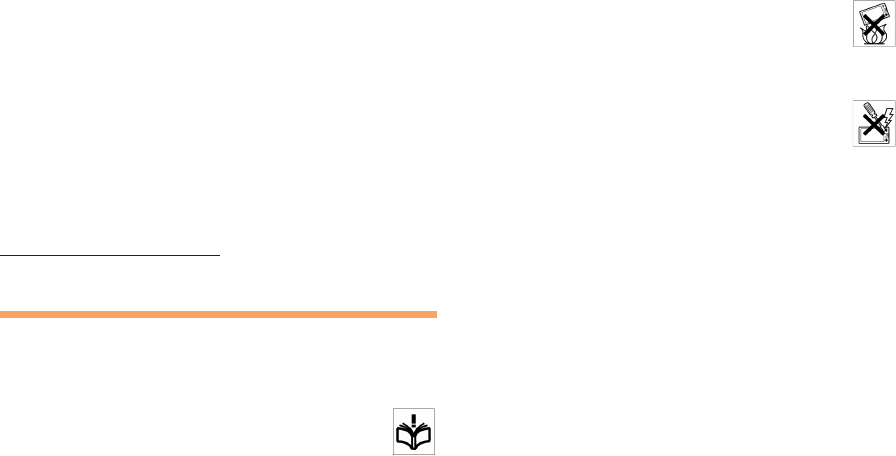
51
difference in safety based on difference in SAR value.
Products with radio transmitters sold in the US must be
certified by the Federal Communications Commission
(FCC). When required, tests are performed when the
phone is placed at the ear and when worn on the body.
For body-worn operation, the phone has been tested when
positioned a minimum of 15 mm from the body without any
metal parts in the vicinity of the phone or when properly
used with an appropriate Sony Ericsson accessory and
worn on the body. Use of the phone other than as tested
may impact SAR and result in non-compliance with such RF
exposure limits. For devices which include “WiFi hotspot”
functionality, body-worn SAR measurements for operation
of the device operating in WiFi hotspot mode were taken
using a separation distance of 10mm. Use of third-party
accessories may result in different SAR levels than those
reported.
For more information about SAR and radio frequency
exposure go to:
www.sonyericsson.com/health.
Guidelines for Safe and Efficient Use
Please follow these guidelines. Failure to do so might
entail a potential health risk or product malfunction. If in
doubt as to its proper function, have the product checked
by a certified service partner before charging or using it.
Recommendations for care and safe use of our products
Handle with care and keep in a clean and dust-free
place.
Warning! May explode if disposed of in fire.
Do not expose to liquid or moisture or excess humidity.
For optimum performance, the product should not
be operated in temperatures below +5°C (+41°F) or
above +35°C (+95°F). Do not expose the battery to
temperatures above +35°C (+95°F).
Do not expose to flames or lit tobacco products.
Do not drop, throw or try to bend the product.
Do not paint or attempt to disassemble or modify the
product.
Consult with authorized medical staff and the instructions
of the medical device manufacturer before using the
product near pacemakers or other medical devices or
equipment.
Discontinue use of electronic devices or disable the radio
transmitting functionality of the device where required or
requested to do so.
Do not use where a potentially explosive atmosphere
exists.
Do not place your product or install wireless equipment in
the area above an air bag in a car.
Caution: Cracked or broken displays may create sharp
edges or splinters that could be harmful upon contact.
Do not use the Bluetooth Headset in positions where it is
uncomfortable or will be subject to pressure.
•
•
•
•
•
•
•
•
•
•
•
•
•

52
Children
Warning! Keep out of the reach of children. Do not allow
children to play with mobile phones or accessories. They
could hurt themselves or others. Products may contain
small parts that could become detached and create a
choking hazard.
Power supply (Charger)
Connect the charger to power sources as marked on the
product. Do not use outdoors or in damp areas. Do not alter
or subject the cord to damage or stress. Unplug the unit
before cleaning it. Never alter the plug. If it does not fit into
the outlet, have a proper outlet installed by an electrician.
When a power supply is connected there is a small drain
of power. To avoid this small energy waste, disconnect the
power supply when the product is fully charged. Use of
charging devices that are not Sony Ericsson branded may
pose increased safety risks.
Battery
New or idle batteries can have short-term reduced
capacity. Fully charge the battery before initial use. Use
for the intended purpose only. Charge the battery in
temperatures between +5°C (+41°F) and +35°C (+95°F).
Do not put the battery into your mouth. Do not let the
battery contacts touch another metal object. Turn off the
product before removing the battery. Performance depends
on temperatures, signal strength, usage patterns, features
selected and voice or data transmissions. Use of an
unqualified battery may present a risk of fire, explosion,
leakage or other hazard.
Personal medical devices
Mobile phones may affect implanted medical equipment.
Reduce risk of interference by keeping a minimum distance
of 22cm (8.7 inches) between the phone and the device.
Use the phone at your right ear. Do not carry the phone
in your breast pocket. Turn off the phone if you suspect
interference. For all medical devices, consult a physician
and the manufacturer.
Driving
Some vehicle manufactures forbid the use of phones
in their vehicles unless a handsfree kit with an external
antenna supports the installation. Check with the vehicle
manufacturer's representative to be sure that the mobile
phone or Bluetooth handsfree will not affect the electronic
systems in the vehicle. Full attention should be given to
driving at all times and local laws and regulations restricting
the use of wireless devices while driving must be observed.
GPS/Location based functions
Some products provide GPS/Location based functions.
Location determining functionality is provided "As is" and
"With all faults". KDDI/Sony Ericsson does not make any
representation or warranty as to the accuracy of such
location information.
Use of location-based information by the device may not
be uninterrupted or error free and may additionally be
dependent on network service availability. Please note

53
that functionality may be reduced or prevented in certain
environments such as building interiors or areas adjacent to
buildings.
Caution: Do not use GPS functionality in a manner which
causes distraction from driving.
Emergency calls
Calls cannot be guaranteed under all conditions. Never rely
solely upon mobile phones for essential communication.
Calls may not be possible in all areas, on all networks, or
when certain network services and/or phone features are
used.
Flight mode
Bluetooth and WLAN functionality, if available in the device,
can be enabled in Flight mode but may be prohibited
onboard aircraft or in other areas where radio transmissions
are prohibited. In such environments, please seek
proper authorisation before enabling Bluetooth or WLAN
functionality even in Flight mode.
Malware
Malware (short for malicious software) is software that can
harm the mobile phone or other computers. Malware or
harmful applications can include viruses, worms, spyware,
and other unwanted programs. While the device does
employ security measures to resist such efforts, KDDI/Sony
Ericsson does not warrant or represent that the device will
be impervious to introduction of malware. You can however
reduce the risk of malware attacks by using care when
downloading content or accepting applications, refraining
from opening or responding to messages from unknown
sources, using trustworthy services to access the Internet,
and only downloading content to the mobile phone from
known, reliable sources.
Accessories
Use only Sony Ericsson branded original accessories and
certified service partners. Sony Ericsson does not test third-
party accessories. Accessories may influence RF exposure,
radio performance, loudness, electric safety and other
areas. Third-party accessories and parts may pose a risk to
your health or safety or decrease performance.
Disposal of old electrical and electronic equipment
Electronic equipment and batteries should not be included
as household waste but should be left at an appropriate
collection point for recycling. This helps prevent potential
negative consequences for the environment and human
health. Check local regulations by contacting your local
city office, your household waste disposal service, the
shop where you purchased the product or calling a Sony
Ericsson call centre. Do not attempt to remove internal
batteries. Internal batteries shall be removed only by a
waste treatment facility or trained service professional.
Disposing of the battery
Check local regulations or call a Sony Ericsson call centre
for information. Never use municipal waste.

54
Memory Card
If the product comes complete with a removable memory
card, it is generally compatible with the handset purchased
but may not be compatible with other devices or the
capabilities of their memory cards. Check other devices
for compatibility before purchase or use. If the product is
equipped with a memory card reader, check memory card
compatibility before purchase or use.
Memory cards are generally formatted prior to shipping. To
reformat the memory card, use a compatible device. Do not
use the standard operating system format when formatting
the memory card on a PC. For details, refer to the operating
instructions of the device or contact customer support.
Warning!
If the device requires an adapter for insertion into the
handset or another device, do not insert the card directly
without the required adapter.
Precautions on memory card use
Do not expose the memory card to moisture.
Do not touch terminal connections with your hand or any
metal object.
Do not strike, bend, or drop the memory card.
Do not attempt to disassemble or modify the memory
card.
Do not use or store the memory card in humid or
corrosive locations or in excessive heat such as a closed
car in summer, in direct sunlight or near a heater, etc.
Do not press or bend the end of the memory card adapter
with excessive force.
•
•
•
•
•
•
Do not let dirt, dust, or foreign objects get into the insert
port of any memory card adapter.
Check you have inserted the memory card correctly.
Insert the memory card as far as it will go into any
memory card adapter needed. The memory card may not
operate properly unless fully inserted.
We recommend that you make a backup copy of
important data. We are not responsible for any loss or
damage to content you store on the memory card.
Recorded data may be damaged or lost when you
remove the memory card or memory card adapter, turn
off the power while formatting, reading or writing data,
or use the memory card in locations subject to static
electricity or high electrical field emissions.
Protection of personal information
Erase personal data before disposing of the product. To
delete data, perform a master reset. Deleting data from
the phone memory does not ensure that it cannot be
recovered. KDDI/Sony Ericsson does not warrant against
recovery of information and does not assume responsibility
for disclosure of any information even after a master reset.
Loudness warning!
Avoid volume levels that may be harmful to your hearing.
FCC Statement for the USA
This device complies with Part 15 of the FCC
rules. Operation is subject to the following two
conditions:
(1) This device may not cause harmful interference, and
•
•
•
•
•

55
(2) This device must accept any interference received,
including interference that may cause undesired
operation.
Any change or modification not expressly approved by
Sony Ericsson may void the user's authority to operate the
equipment.
This equipment has been tested and found to comply with
the limits for a Class B digital device, pursuant to Part 15
of the FCC Rules. These limits are designed to provide
reasonable protection against harmful interference in a
residential installation. This equipment generates, uses and
can radiate radio frequency energy and, if not installed
and used in accordance with the instructions, may cause
harmful interference to radio communications. However,
there is no guarantee that interference will not occur in a
particular installation.
If this equipment does cause harmful interference to radio
or television reception, which can be determined by turning
the equipment off and on, the user is encouraged to try
to correct the interference by one or more of the following
measures:
- Reorient or relocate the receiving antenna.
- Increase the separation between the equipment and
receiver.
- Connect the equipment into an outlet on a circuit different
from that to which the receiver is connected.
- Consult the dealer or an experienced radio/TV technician
for help.
Industry Canada Statement
This Class B digital apparatus complies with Canadian
ICES-003.
Cet appareil numérique de la classe B est conforme à la
norme NMB-003 du Canada.
This device complies with RSS-210 of Industry Canada.
Operation is subject to the following two conditions:
(1) this device may not cause interference, and
(2) this device must accept any interference, including
interference that may cause undesired operation of the
device.
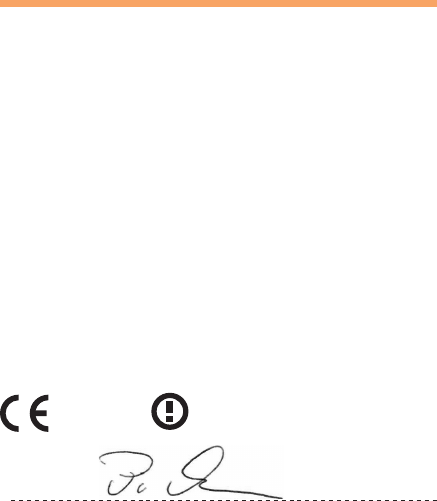
56
Declaration of Conformity for CDMA SOI12
We,
Sony Ericsson Mobile Communications AB of
Nya Vattentornet
SE-221 88 Lund, Sweden
declare under our sole responsibility that our product
Sony Ericsson type AAH-5880016-BV
and in combination with our accessories, to which this
declaration relates is in conformity with the appropriate
standards EN 301 511:V9.0.2, EN 301 489-7:V1.3.1, EN 301
908-1:V4.2.1, EN 301 908-2:V4.2.1, EN 301 489-24:V1.5.1,
EN 300 440-2:V1.4.1, EN 301 489-3:V1.4.1, EN 300 328:
V1.7.1, EN 301 489-17:V2.1.1, EN 302 291-2:V1.1.1 and EN
60950-1:2006 +A11:2009+A1:2010, following the provisions
of Radio Equipment and Telecommunication Terminal
Equipment Directive 1999/5/EC
Lund, December 2011
0682
Signature
Pär Thuresson
Chief Quality Officer
Head of Quality & Validation
われわれはR&TTE指令の要求事項を満たしています(1999/5/EC)
We fulfill the requirements of the R&TTE Directive (1999/5/
EC)

57
End User Licence
Agreement
Software delivered with this device and its media is owned
by Sony Ericsson Mobile Communications AB, and/or its
affiliated companies and its suppliers and licensors.
Sony Ericsson grants you a non-exclusive limited licence
to use the Software solely in conjunction with the Device on
which it is installed or delivered.
Ownership of the Software is not sold, transferred or
otherwise conveyed.
Do not use any means to discover the source code or any
component of the Software, reproduce and distribute the
Software, or modify the Software. You are entitled to transfer
rights and obligations to the Software to a third party,
solely together with the Device with which you received the
Software, provided the third party agrees in writing to be
bound by the terms of this Licence.
This licence exists throughout the useful life of this Device.
It can be terminated by transferring your rights to the
Device to a third party in writing. Failure to comply with any
of these terms and conditions will terminate the licence
immediately.
Sony Ericsson and its third party suppliers and licensors
retain all rights, title and interest in and to the Software. To
the extent that the Software contains material or code of a
third party, such third parties shall be beneficiaries of these
terms.
This licence is governed by the laws of Sweden. When
applicable, the foregoing applies to statutory consumer
rights. In the event Software accompanying or provided
in conjunction with your device is provided with additional
terms and conditions, such provisions shall also govern
your possession and usage of the Software.

58
About Open Source
Software
This product includes certain open source or other software
originating from third parties that is subject to the GNU
General Public License (GPL), GNU Library/Lesser General
Public License (LGPL) and different and/or additional
copyright licenses, disclaimers and notices. The exact
terms of GPL, LGPL and some other licenses, disclaimers
and notices are reproduced in the about box in this product
and are also available at http://opensource.sonyericsson.
com.
Sony Ericsson offers to provide source code of software
licensed under the GPL or LGPL or some other open
source licenses allowing source code distribution to you
on a CD-ROM for a charge covering the cost of performing
such distribution, such as the cost of media, shipping and
handling, upon written request to Sony Ericsson Mobile
Communications AB, Open Source Software Management,
Nya Vattentornet, SE-221 88 Lund, Sweden. This offer is
valid for a period of three (3) years from the date of the
distribution of this product by Sony Ericsson.
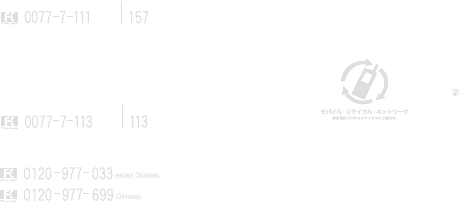
For inquiries, call:
au Customer Service Center
For general information and charges
(toll free)
For loss, theft or damage and operation information
(toll free)
From fixed-line phones:
PRESSING ZERO WILL CONNECT YOU TO AN OPERATOR
AFTER CALLING 157 ON YOUR au CELL PHONE
From au cell phones:
From fixed-line phones: From au cell phones:
area code not required
area code not required
In case above numbers are not available,
Cell phone and PHS operators collect and recycle unused
telephones, batteries and battery chargers at stores
bearing the logo regardless of brand and manufacturer
to protect the environment and reuse valuable resources.
Sales: KDDI CORPORATION
•
OKINAWA CELLULAR TELEPHONE COMPANY
Manufactured by: Sony Ericsson Mobile Communications Japan, Inc.
1250-0245.1
June 2011,1st Edition